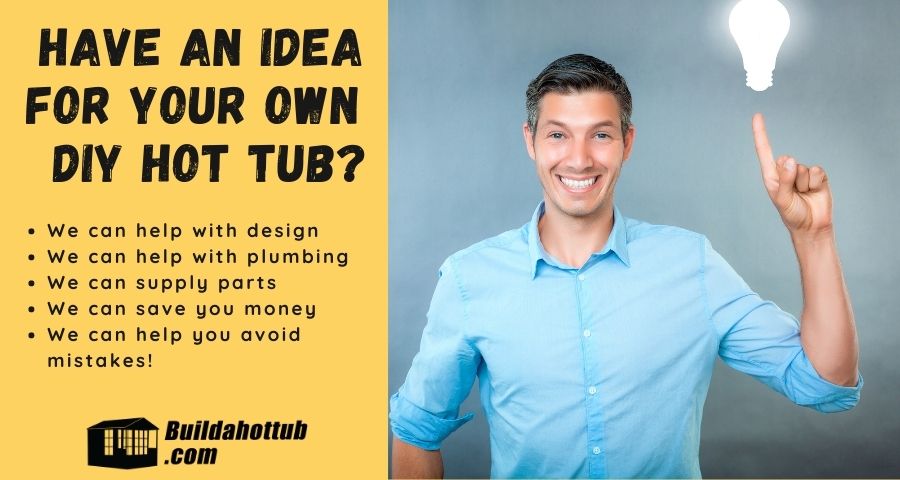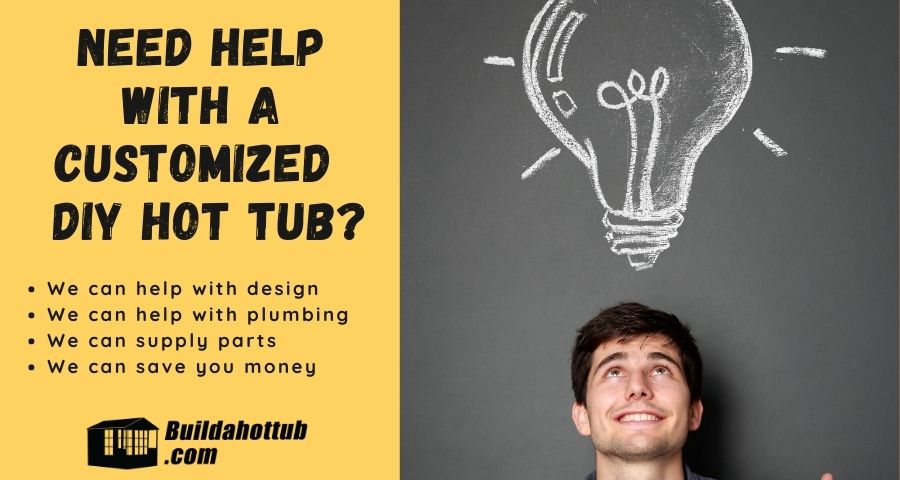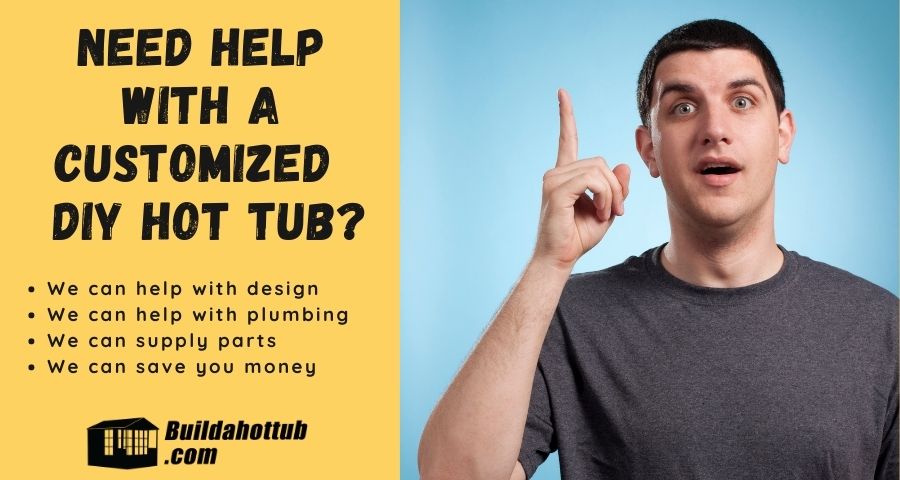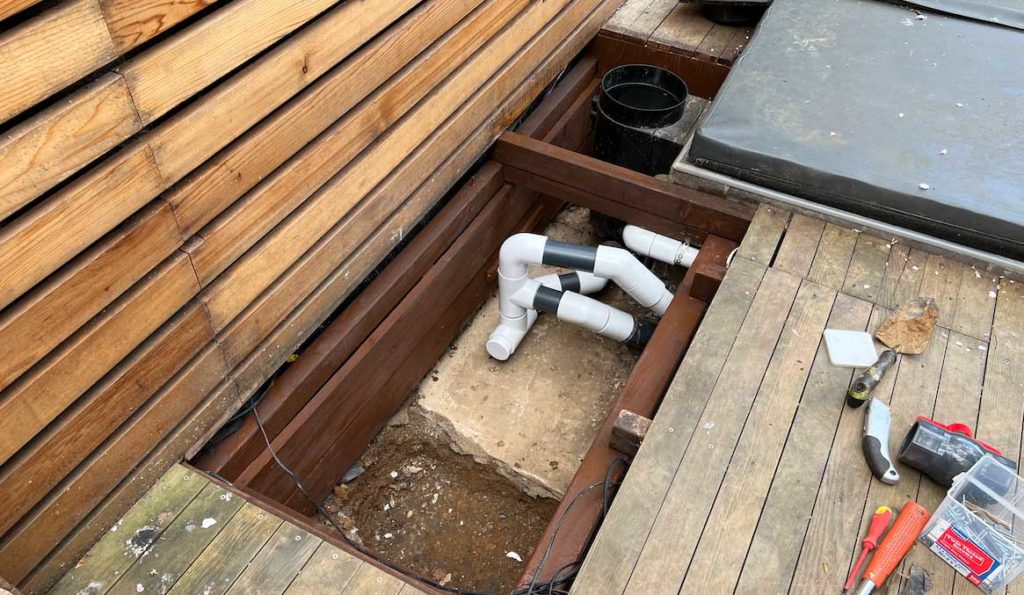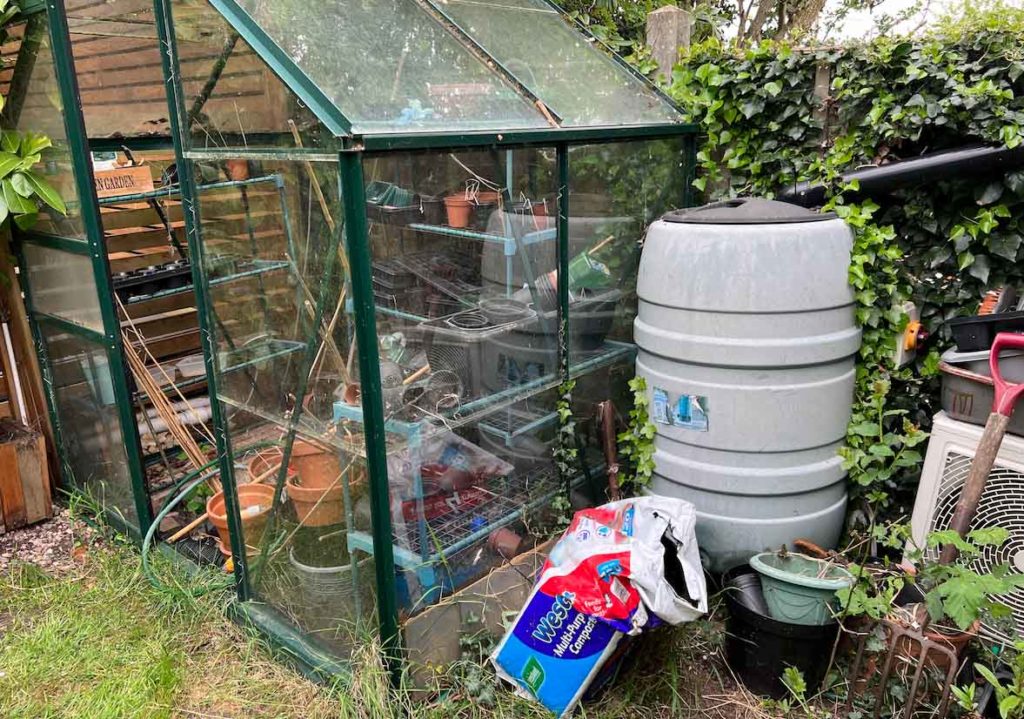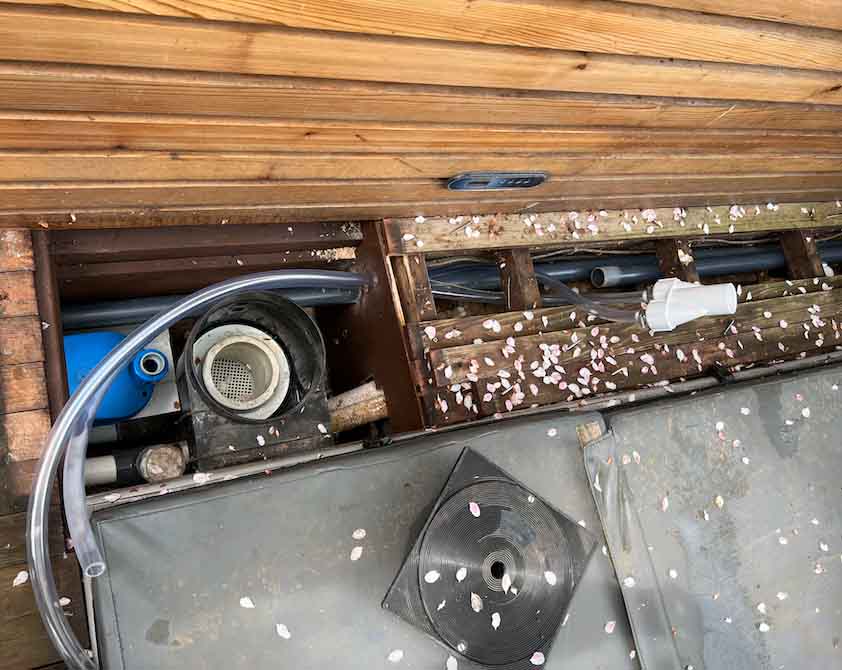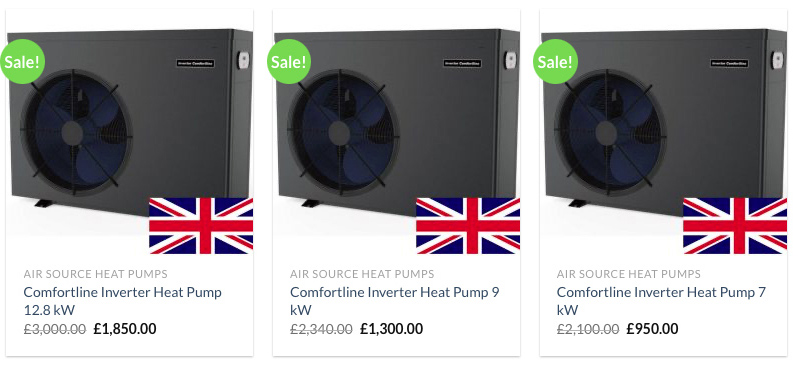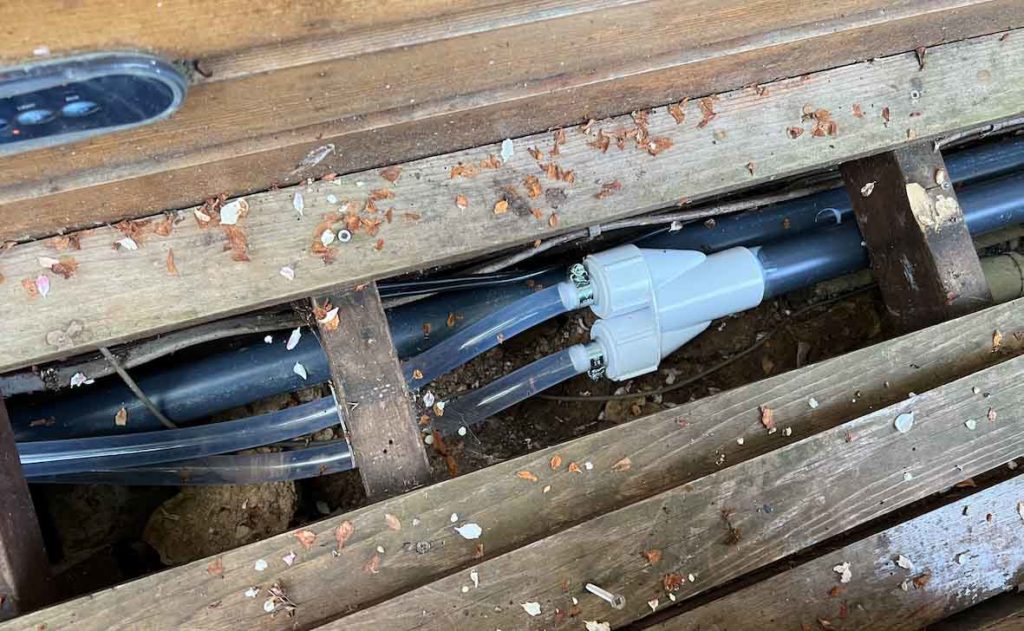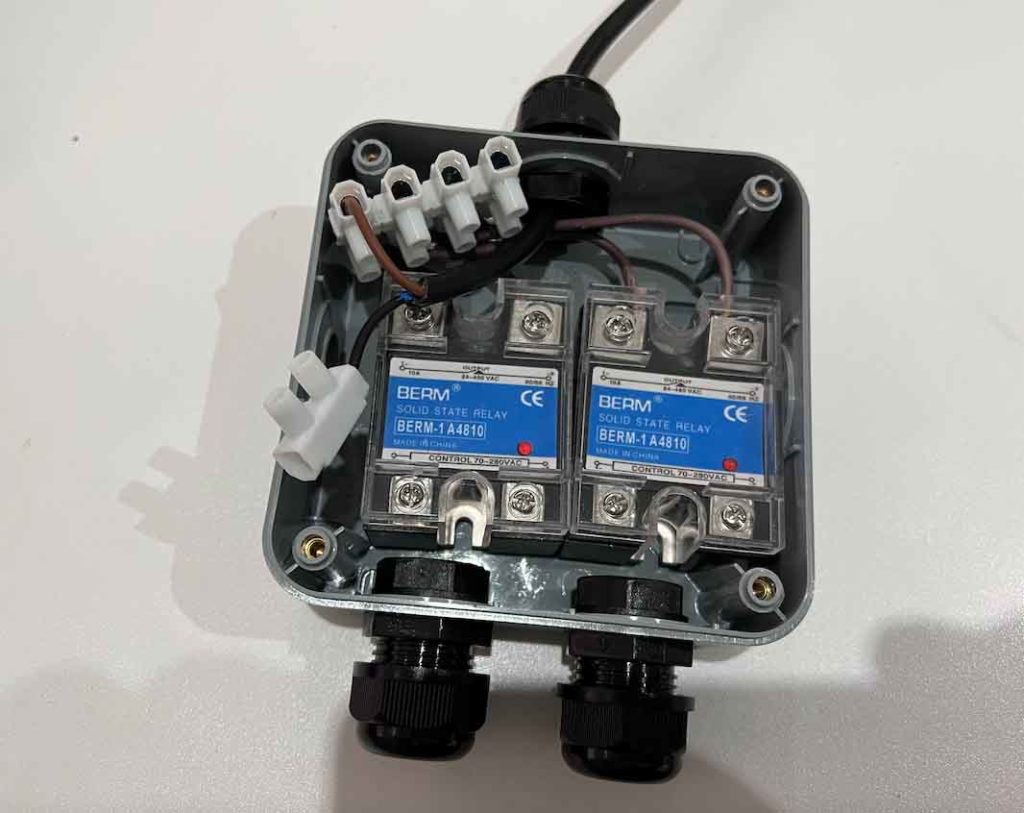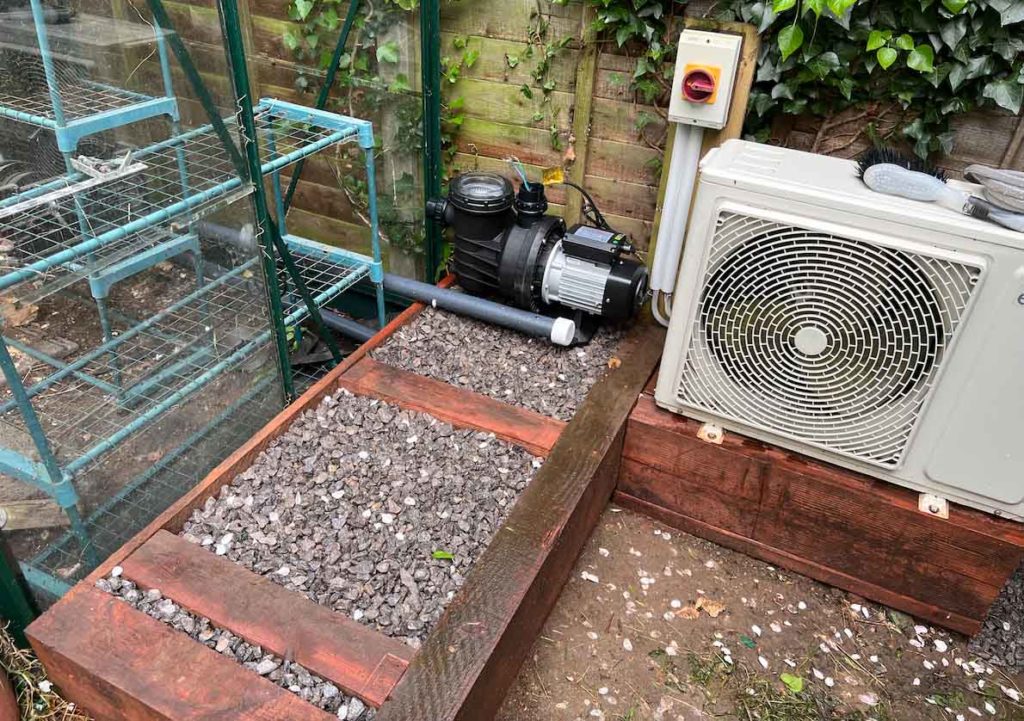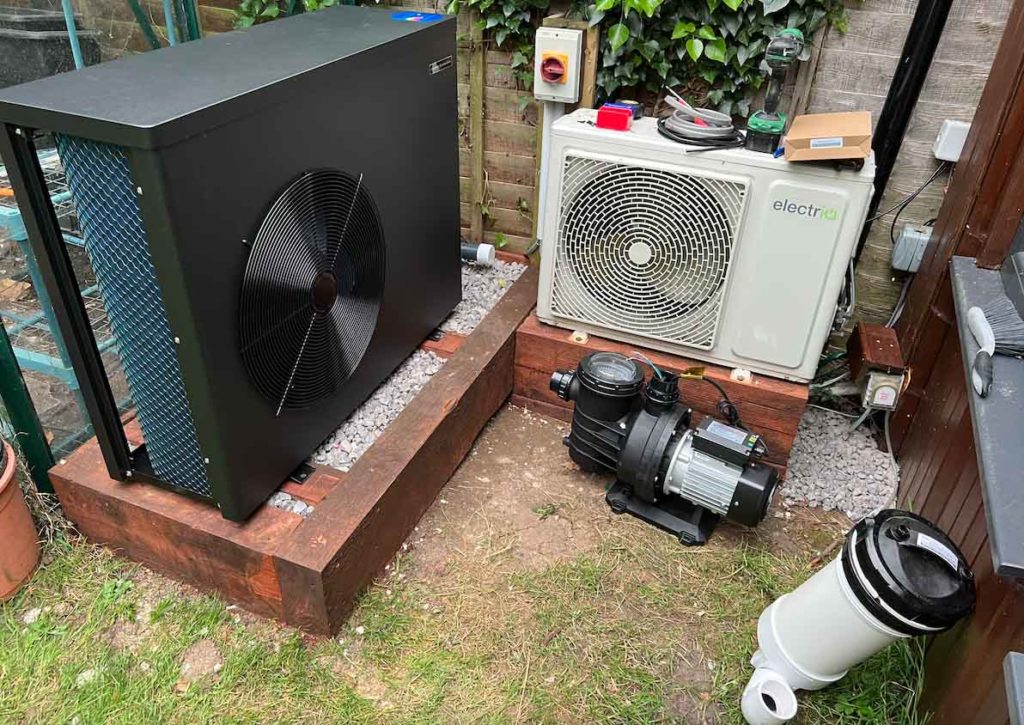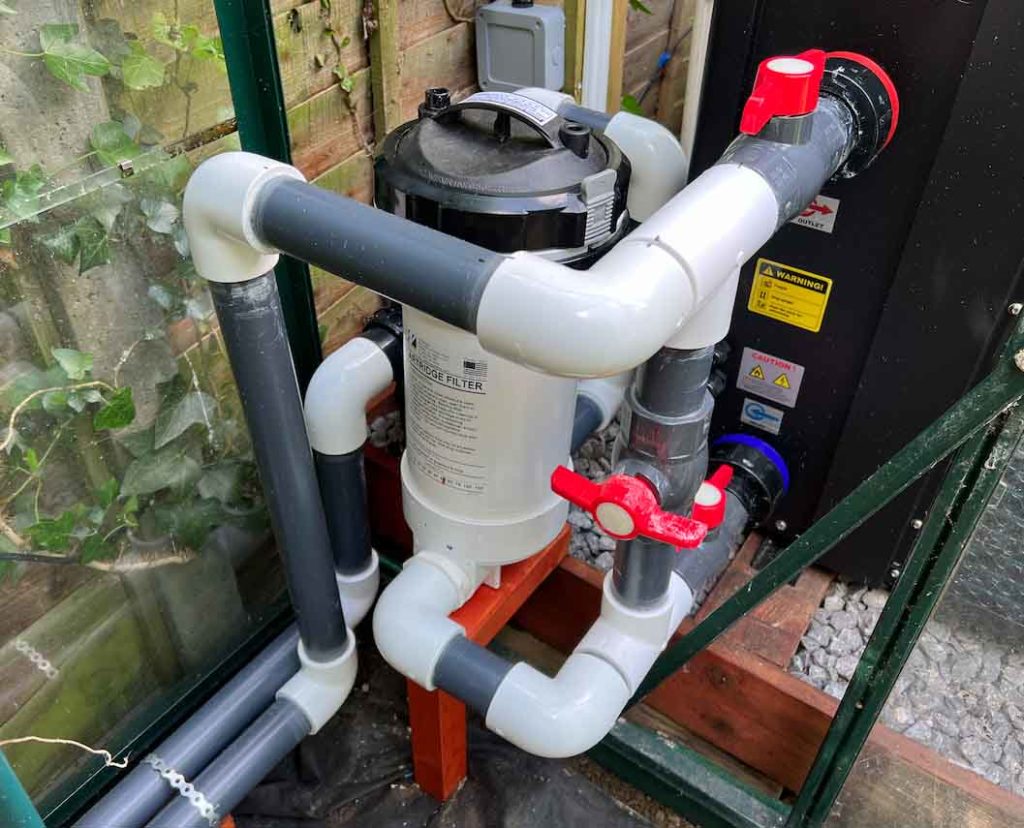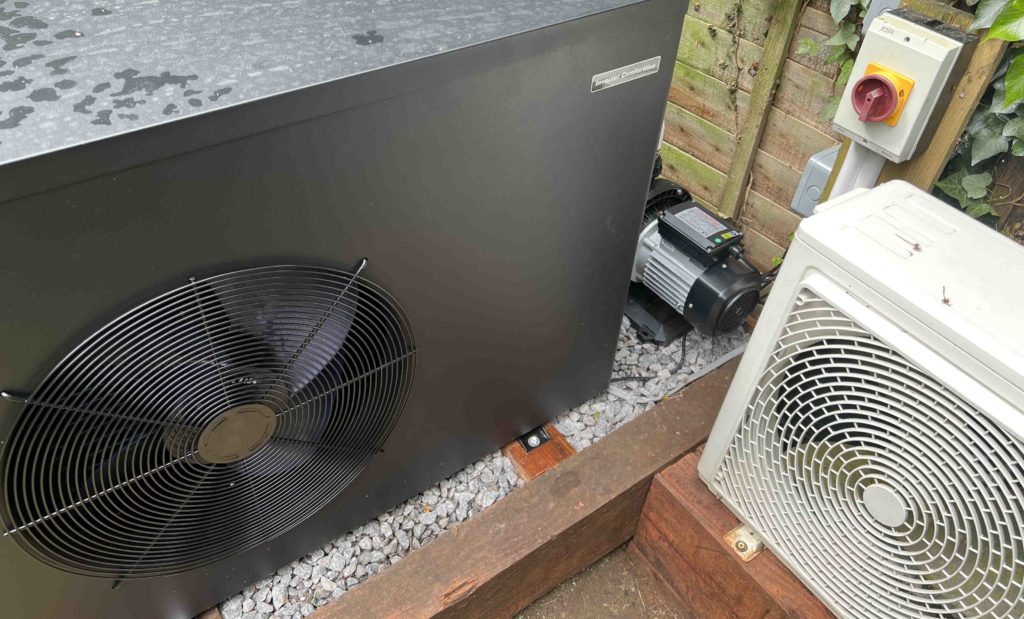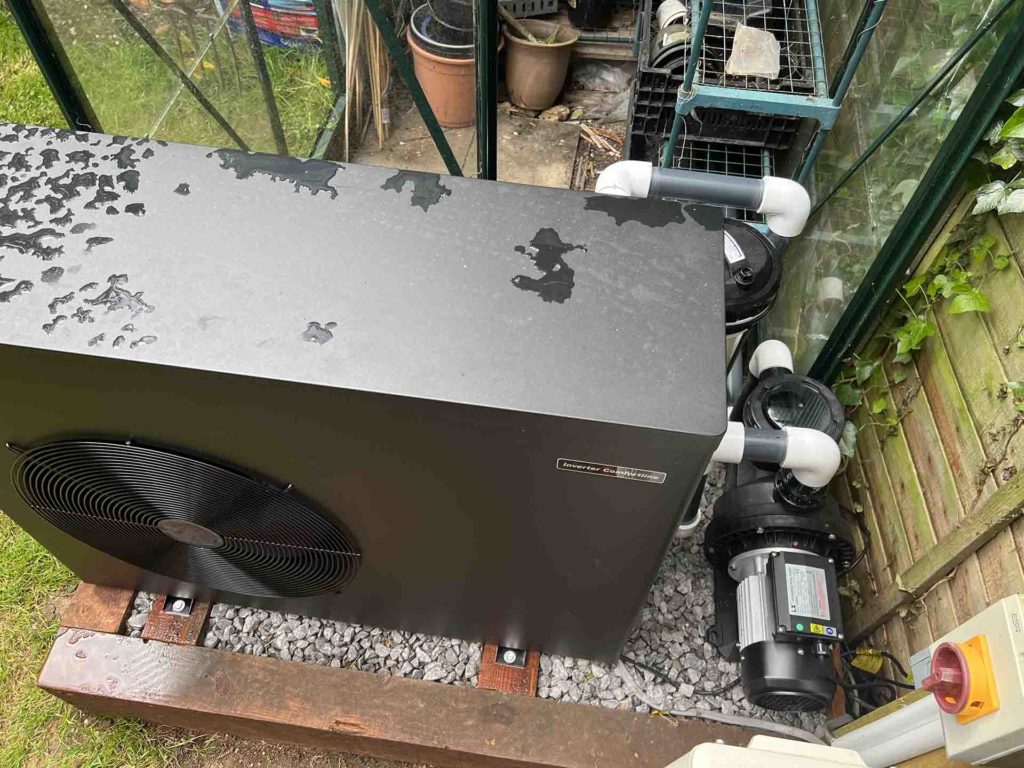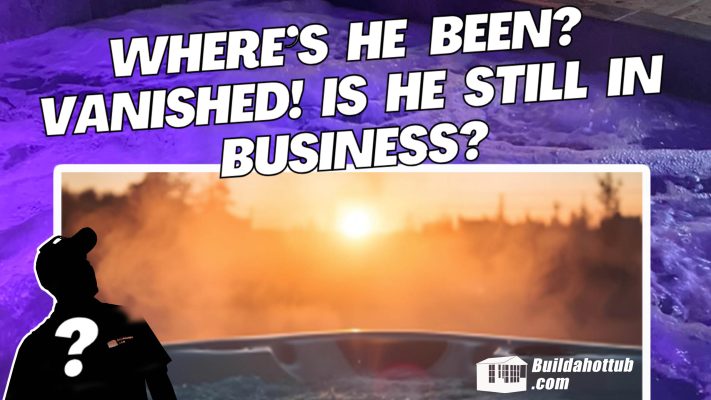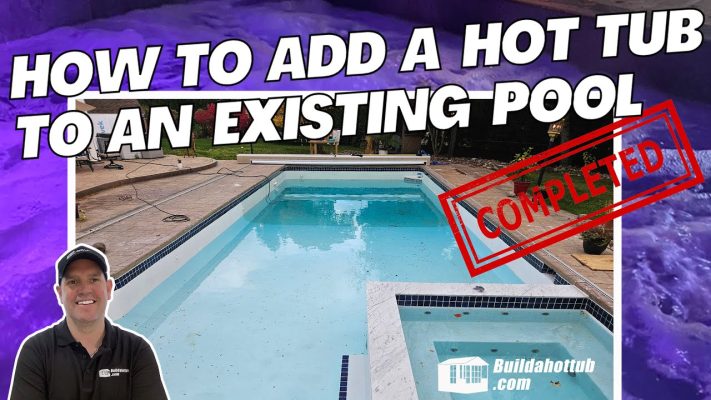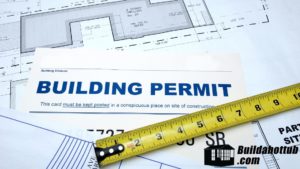How to Build a DIY Hot Tub
Build a hot tub? When I wanted to put a Hot Tub in the back garden, after sizing it up, it was just not going to fit, however hard I tried. Not because of the space, just the fact that there are a few tight corners that even up ended, on its side, with lots of people to help and manoeuvre it, a regular hot tub would just not going to get through. That was not going to stop me getting what I wanted most – a Hot Tub! I needed to build a Hot Tub.
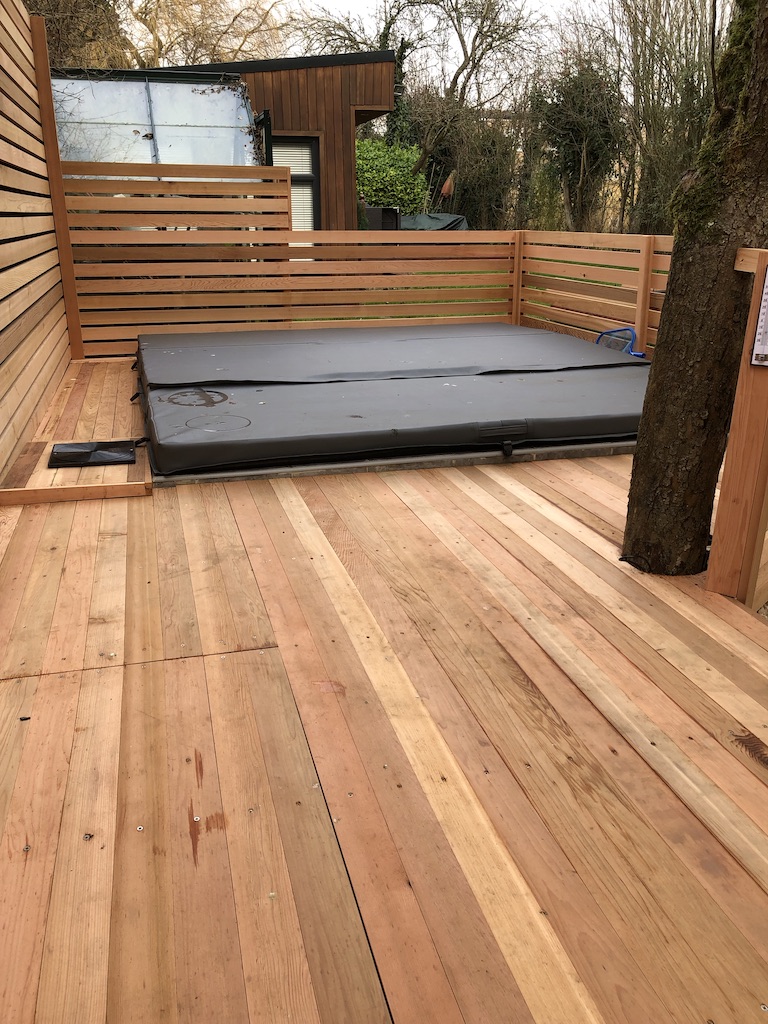
From my initial research, there were no “how to” guides on the web. A couple of other DIYers had done it and some had posted a few helpful things, but they didn’t cover everything and left me with questions. Therefore, I thought why not write the definitive guide when I’m done?
The image above is the finished article. It’s fantastic! This website is the culmination of the knowledge that I have acquired along the way that I wanted to share with you all. I’ve put together this guide where I am to cover everything you need to build your own DIY hot tub.
We have high fences so it couldn’t come through a neighbours garden. There is no access from the rear of my property. Having a crane do the job and drop it in apart from looking a bit of a “tool” in front of the neighbours, it wouldn’t actually help either as the tight corners are at the bottom of the garden where I wanted the Tub to go. It was too long for a crane. Being of the mindset that I was not going to let this one go, I had the bright idea that I needed to build my own Hot Tub.
The Hot Tubs that I had been in at Health Clubs or Spa Hotels in the past were not the plastic shell type that you see plastered all over the internet. They were solid, rather like a swimming pool. A hole in the ground a few tiles, I could do that i thought to myself! I knew nothing about building a hot tub so this guide is the culmination of the knowledge that I have acquired along the way in building my hot tub.
From my initial research, there were no “how to” guides on the web. A couple of other DIYers had done it and some had posted a few helpful things, but they didn’t cover everything and left me with questions. Therefore, I thought why not write the definitive guide when I’m done?
So, the catchy title. Yes, it is possible to do. I am testament to this. You can build a high quality Hot Tub for under £5K / $5K. You can also spend a lot more than this too if you wish, but that is totally up to you. In this website we’ll look at all the aspects I considered and of course some that I should have thought about with hindsight. We’ll also look at where you can save money and some of the things I did right and others that I would change if I ever build another one.
Just a final word before we get going. I’m not a builder but a keen DIYer. I keep myself reasonably fit and healthy so, before undertaking a project like this, please make sure you are physically able to do so and please do your research and know your own limits! I wont be held responsible for any injuries or mistakes – this website is for information purposes only so use it at your own peril!
Why build a Hot Tub when I can buy one?
Space / Difficult Access
As you have read from the introduction, this was the primary reason that I embarked on my own Hot Tub Project – I just couldn’t get a shop bought one into the space that I wanted. Bringing in the raw materials wasn’t a problem so it made sense for me.
Build Quality
Hot Tubs are becoming more and more popular. Once seen as a sign that a person was “doing well” for many, (like me now!) they are becoming a lifestyle. From my own experience, there is nothing better than relaxing in the Hot Tub after a long stressful day at work with a nice cold beer! There are many that will tell you about the heath benefits of using a Hot Tub; I’m not going to go there in this website as we’ve established I’m already not a builder writing a building website so why should I be offering health tips? – I’m clearly not a health care professional!
Due to the rise in popularity, the number of makes and models on the market continues to grow. Put Hot Tubs into Google and see for yourself. As you would expect, the quality does vary. Some of the top names brands are associated with the USA and “American Hot Tubs” and “American Made”. On the other side of the coin, like most things on the planet, some are made in China.
There has been an influx of cheaper Chinese-made Hot tubs launch onto the market. Yes, the prices are certainly lower, under £3K/$3K in some cases, but as you may or may not expect, you do get what you pay for and the build quality is not the best.
The components used are also not of the highest quality and will eventually fail. In building my Hot Tub, I only used branded components from those “American” brands like Balboa and Waterway. I’m not affiliated to these in anyway, they were just my “go to” as the market leaders in an industry I knew little about. What I achieved in essence was a much bigger and a higher specification build with better components for my £5K/$5K than if I bought an off-the-shelf plastic shell tub for the same price.
Build a Hot Tub to Add Value to your Property
You probably haven’t thought about this, but if it is made of bricks and mortar and is a permanent feature in the property, they it will add value to your home. I know this from personal experience when I was looking to have my office included in the valuation of my own home. As I built it from timber frames, the valuer was not interested – he was only interested in anything made of brick that would still be in existence after a fire.
An in-ground pool made from concrete and stone may add value. Your home’s resale price could go up by as much as 50% the cost of the pool by having it made from nicer materials. – https://www.amerifirst.com
Therefore, this means that you can potentially offset either just in your mind, or physically, the cost of building your home made brick hot tub – food for thought when you are trying to convince your other half that this is a good use of the spare cash you have!
Customization:
Unleash your inner designer and create a hot tub that’s truly unique. Choose the size, shape, and materials that perfectly suit your needs and preferences. Want a hexagonal hot tub with underwater LED lighting and a built-in waterfall? Go for it!
Standard hot tubs often come with limited features. When you build your own, you can incorporate all the bells and whistles you desire, like aromatherapy diffusers, massage jets, or even a swim deck.
Pride
From personal experience, there is nothing better than having a few friends over to use the Hot Tub that you built! The best compliment you can get to this extent is “does it come as a kit” – I love it when I hear that – means I did something right with the build.
OK, so you’ve decided that this is the way forward and you still want to build your own Hot Tub, let’s get started on how to build a Hot Tub.
Planning, Planning and more Planning
Planning is key. If the planning stage is done correctly, it will make the rest of the build much easier.
I learnt the hard way by not planning to have enough space for my “control room” as I call it which is where your pump and electronics go; we’ll look at this later in this website.
There are quite a few things to consider so in this a chapter, we’ll take a look at the variables.
Location to Build a Hot Tub
So where are you going to put your Hot Tub? You may not have the luxury of multiple potential locations in your garden, but if you do, here are a few things to think about. How are you going to fill it? Yes, your Hot Tub is going to need water and it is going to need topping up every month or so depending on the use so you need to have a water source eg tap nearby. Yes you can run a hose, but it doesn’t look as good as getting the plumbing right for being able to fill the tub.
How are you going to empty it? You are going to need to do this a couple of times a year minimum to make sure your water is nice, clean and healthy. How are going to empty your tub?
With the volume of water and chemicals, you are not going to be watering your flowers with this water!
Where is the drain and how are you going to get there? For this one, you can run a hose when you need to empty it and we’ll discuss this when we look at plumbing.
What do you want to look at when you are in the tub? Is there a view? Perhaps this may seem an odd point, but if you do have the option of a view, you really want to take it as opposed to looking at a wall! This can also potentially affect where you place the plumbing and jets. These are also not options that you would get with a shop bought tub. You get to customise this to your exact requirements.
Where are you going to locate your “control room”? Pumps, pipes, blowers, all take space and need to have it allocated and allowed for.
You are going to need electricity to your tub one way or another and we will look at this later in the website in a chapter dedicated to electricity. Where is it going to plug in?
What landscaping are you planning. Do you need space for a deck around your Hot Tub or space for steps. Lots of things to think about on the location but most of these will depend on where you are planning to install your tub.
Additional Considerations:
- Noise: Be mindful of noise disturbances for yourself and your neighbors. Place the hot tub away from bedrooms or property lines.
- Wind and Snow: In windy areas, consider windbreaks or shields to prevent heat loss and maintain comfortable soaking temperatures. In snowy regions, ensure easy access for clearing snow around the hot tub.
For me, I needed to clear away some space. This is what it looked like before I cleared the area.
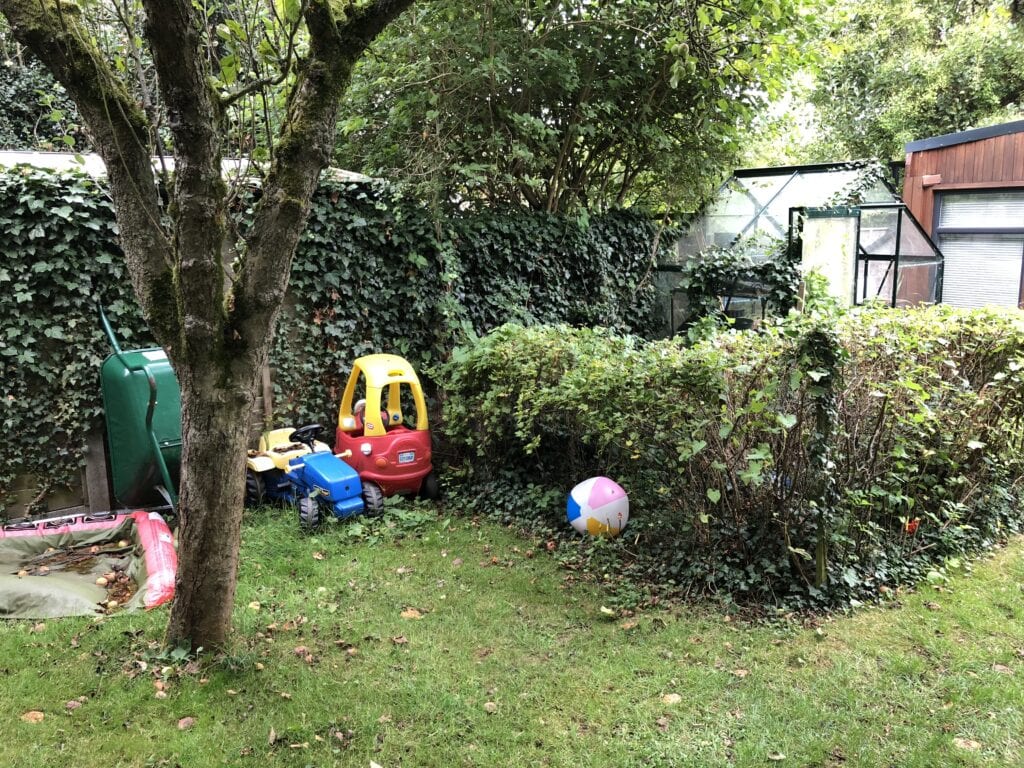
As you can see, the area was somewhat wasted. A parking lot for the kids toys and a Goosbery bush that I was not fond of anyway. After a few hours on a Sunday afternoon, it was looking more like space for a Hot Tub.

You can see in the above picture that I was very much still planning at this stage. Trying to work out sizes and what the actual dimensions of the Hot Tub were going to be. At one stage I even had the wife and kids sitting in the dirt pretending to be in the tub so I could try and gauge the size of it.
Build a Hot Tub – Above ground or in ground?
This is a crucial question as it will affect the design of your tub. Personally, I chose in ground as I wanted it to be as minimal as possible in my garden. I also liked the idea of dropping into the ground rather than “being on display” for all the neighbours to see. I also was a little nervous about the brickwork and how well I was actually going to lay blocks as I had not done it before. There is quite a bit of water volume in the tub, 2800 litres in my case which is nearly 3 tonnes of weight. By opting for an in ground tub, I knew that I could back fill the brick work with concrete so this was going to minimise the potential for a wall to split and flood my garden!
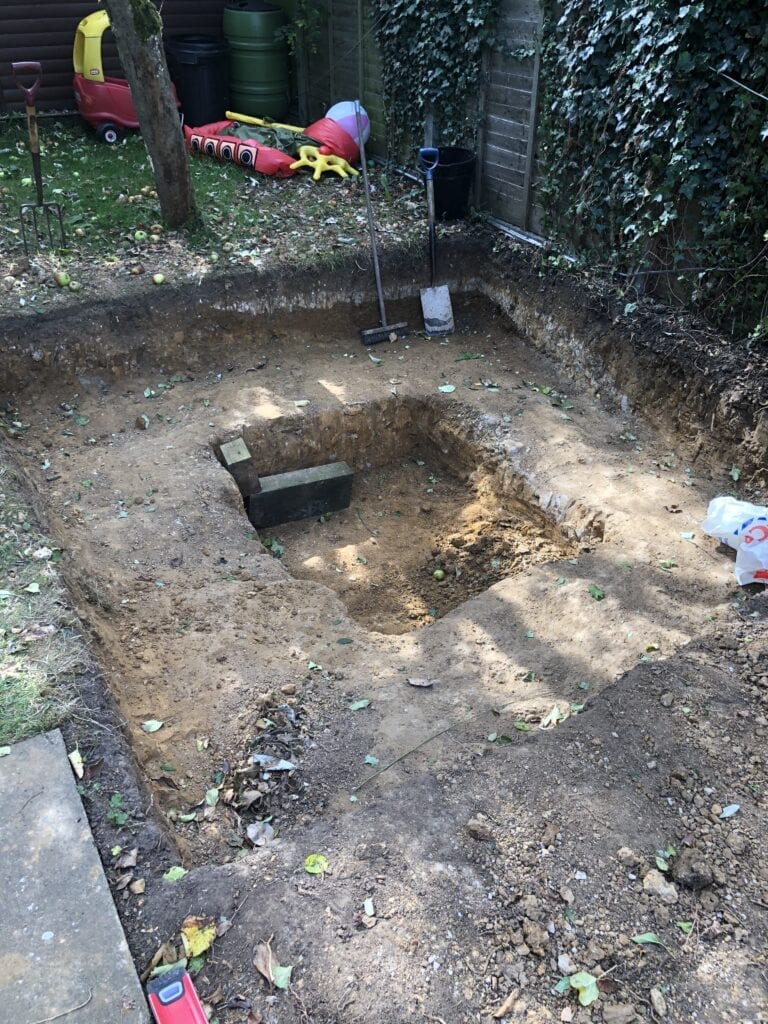
Choosing between an in-ground or above-ground hot tub is a big decision, as each has its own set of pros and cons to consider. Here’s a breakdown to help you decide:
In-Ground Hot Tubs:
Pros:
- Aesthetics: Seamlessly integrates into your landscape, creating a luxurious and permanent fixture.
- Customization: Design freedom allows for unique shapes, sizes, and materials to match your vision.
- Durability: Built-in construction offers sturdiness and longevity, especially with materials like concrete or stone.
- Comfort: Deeper soaking depth provides enhanced buoyancy and a more immersive experience.
-
Cons:
- Cost: Significantly more expensive than above-ground options due to excavation, installation, and material costs.
- Installation: Requires extensive planning, permits, and professional installation, making it a longer and more complex process.
- Maintenance: Cleaning and accessing interior components can be more challenging due to their fixed nature.
- Relocation: Difficult and costly to move if you ever decide to relocate the hot tub.
Above-Ground Hot Tubs:
Pros:
- Affordability: Generally much cheaper than in-ground options, making them ideal for budget-conscious buyers.
- Easy Installation: Can be set up quickly and relatively easily on a level surface, often by yourself.
- Portability: Can be moved to a new location if needed, providing flexibility and resale value.
- Maintenance: Easier to access and clean the interior components due to their portable nature.
Cons:
- Aesthetics: May appear less integrated into the landscape and can sometimes look bulky or out of place.
- Durability: Less sturdy than in-ground options, with materials like acrylic or plastic being more susceptible to wear and tear.
- Comfort: Shallow soaking depth compared to in-ground models, and may feel less spacious.
- Customization: Limited design options compared to in-ground choices.
Ultimately, the best choice for you depends on your priorities and budget. If aesthetics, customization, and a luxurious feel are paramount, an in-ground hot tub might be worth the investment. However, if affordability, ease of installation, and portability are your main concerns, an above-ground model might be the better option.
Consider your available space, desired features, and budget to make an informed decision. You can also consult with landscaping professionals or hot tub retailers for personalized advice based on your specific needs.
I hope this helps!
External Roof or Indoors?
Are you planning on building a roof over your Hot Tub or even a full building? This is the time for making all these decisions and plans as the later you leave it, the harder changes. Things like positional footings would have to be considered at this stage, not something you want to be adding afterwards.
Physical Dimensions & Design
For me, this was the biggest consideration. Whilst I had the space for a larger Hot Tub, there were a few things I hadn’t considered. My initial design was about 50cm/20″ larger in each direction. You can see the dimensions at the end of this guide, but what I hadn’t considered was heating and filtering. My Hot Tub is a good size, comfortably being able to seat 10 adults. I wanted something where the kids could play in it without climbing all over my wife and me – there was a method in my madness! That said, what I hadn’t considered was the heating.
With the dimensions that I had, taking me to over 4000 litres of water, I was verging on a small swimming pool. Once you hit swimming pool size, you start to enter into what I affectionately began to call “Swimming Pool Tax”. “Swimming Pool Tax” is not something that the government or local authorities are going to collect from you, it is what I affectionately called the additional cost of any components that are swimming pool size or compatible.
For example, if hot tub component “X” is fifty quid (50 USD), the swimming pool equivalent of component “X” is seventy five quid (75USD)- the difference being my “Swimming Pool Tax” This was the case on things like filters, lights, drains, skimmers, all these things that by increasing the size I needed to move into the “Swimming Pool Tax” territory.
The biggest point here about the size was the heating. Whilst at this stage I had not considered the running costs (we’ll look at those later too) it was the practical nature of heating the tub up to temperature. You want to be running your tub at somewhere between 37 and 40 degrees (98-104F). To get 4000 litres of water to that temperature and to maintain it was going to be a challenge!
When I spoke to my Spa & Hot Tub Component supplier John who is very knowledgeable and was extremely helpful throughout the build, he was suggesting I needed a custom built heating element that was 12Kw. This is 4x the heater that I have in my tub now and 4x the heaters of most tubs! This was before I got to the cost to purchase and to run (about £1.70 ($1.70) an hour!) that was just mind boggling! Needless to say, I stayed away from that.
I dropped the dimensions down, added larger internal steps and seats to decrease the overall volume of water and brought it back to a level where I could use an “off the shelf” Spa Pack – this is the heater and electronics to control the pumps and blower etc. So when you are designing your layout, you need to mindful of not just the dimensions but the volume of water. This will also dictate what filter you need and what pump you will need and what your ongoing running costs are going to be.
Materials
What are you going to build a hot tub out of? I am sure you have already had a look around YouTube where you can find some interesting videos for tubs made of wooden barrels and various other recycled materials. I’m also sure you have seen the “shotcrete” or “gunite” swimming pools and spas being made.
These are really cool to watch and they involve the pool or spa to be formed with a metal rebar structure. The piping and plumbing is then attached in place to the rebar and the whole thing is filled with concrete that is sprayed in at high pressure then skimmed flat. For us DIYers, this is not an option. Very cool, but requires a lot of skill that even those of us who think we can do anything (me!) should stay away from.
There is a simpler option to build a hot tub. I opted for blocks, concrete and mortar and would highly recommend this method. As a newbie to brick laying, firstly it works, I’m testament to this and it wasn’t overly difficult. The other thing I was able to do with this method was use lots and lots of concrete. Being a first time brick layer, I wanted to make sure that the structure I was creating was going to withstand the pressure. Being able to backfill behind the blocks (if you remember I opted for in ground construction) gave me total peace of mind that I was going to create a very strong structure.
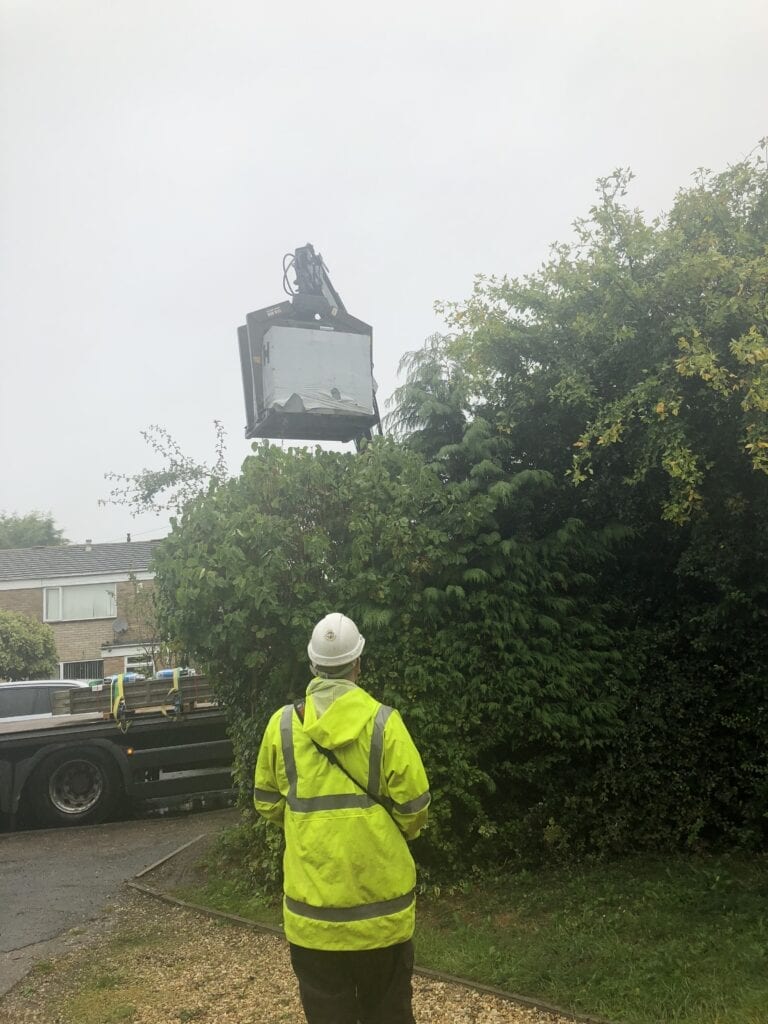
The other thing you need to think about when you build a hot tub is what finish you are going for. It is totally possible (and cheaper) to skim the tub over with a waterproof concrete render, and then paint it with a waterproof paint. Are you considering the swimming pool approach with the small tiles? Fiddly, but they do look nice. Or, are you considering something like the finish I went for which was waterproof floor or wall tiles. I also went for quite large tiles to minimise the about of joints and grouting needed. You don’t actually need specialist tiles as long as they are waterproof and suitable for walls and floors, you should be able to use them.
In regards to materials, at every stage ask yourself how is this adding to the waterproofing of the tub? Every element needs to be adding to this. You should be adding water proofing agent to your mortar for laying bricks, waterproofing agent into your render, some form of sealant over your render (I used PVA) and then if you are using tiles (which we have already established should be waterproof themselves) both the grout and adhesive need to be swimming pool grade which is waterproof too.
Shape
When you build a hot tub what shape are you going to opt for? Remember, this website is concentrating on building using concrete blocks, they are square! Most of your shop bought tubs are cylindrical. It is certainly easier to make a square tub using cinder blocks, and they are quite easy to cut with the right saw (15 quid ($15 USD) off Amazon) so you could create a hexagonal or a more ambitious shape if you wish. Do remember that you are potentially going to be tiling this too so the more ambitious the shape, the more difficult the tiling is going to be. Food for thought
Plumbing, Lighting and Audio Visual
At this stage, eg the design stage, you need to be thinking about where your jets are going to go. Consider underwater lighting (yes you should as it looks really cool) and any other Audio Visual components you are thinking of having. For example, do you want speakers and some form of Bluetooth system for sending audio from your phone?
We do have a full chapter on plumbing, but one of the things I would like you to think about at this stage is where is the skimmer going to go (This is the top filtering element where bits of debris from the surface drop into a basket so can be removed) and also where are the two bottom drains going to go. You need two so if one does get blocked, it is not going to ruin your pump. Incorporate these into your design now rather than later. Certainly, this should be done before you break ground.
Plumbing
After the physical integrity of the hot tub structure, the plumbing is probably the next most import part. After all, without the plumbing, you don’t have a hot tub. As an overview, the concept of a hot tub is pretty simple. Tub is full of water. Water is floing through the skimmer at the top and through the drains (drawn in by the pump inlet) at the bottom. Water flows from skimmer and drains into the filter, from the filter into the heater. From the heater into the pump and from the pump out into the jets. The concept is basic right? Correct, it is not a difficult concept. However, there are a few challenges to get to this point.
Gunite Jet Bodies and Jets for your DIY Hot Tub
This was one of the more difficult things for me to get my head around when I was planning my build. I had never seen any of these components so I was searching for diagrams and videos on YouTube. None of them really enabled me to understand exactly how they worked and I was taking a bit of a chance when I ordered them as they are not cheap.
I knew that I needed this style of jet as they needed to go through my breeze blocks and conceptually, this was similar to the gunite systems that they are designed to be used in. Let’s start with what these components are not. You will not find these on your plastic shell hot tubs. They are not suitable for this at all. Everything is different. These components are really designed for fancy sprayed in concrete construction method that I touched on earlier “shotcrete” or “gunite” – essentially concrete sprayed into a metal construction under high pressure and then skimmed smooth. Very technical and difficult to do – not even for the competent DIYer. So these components are essentially designed to be set into concrete. Ok, we’re now onto something here. With our breeze block construction, we can make use of these components. Before we talk about how to fit them, let’s take a step back and explain how they actually work as this was the bit I struggled to understand.
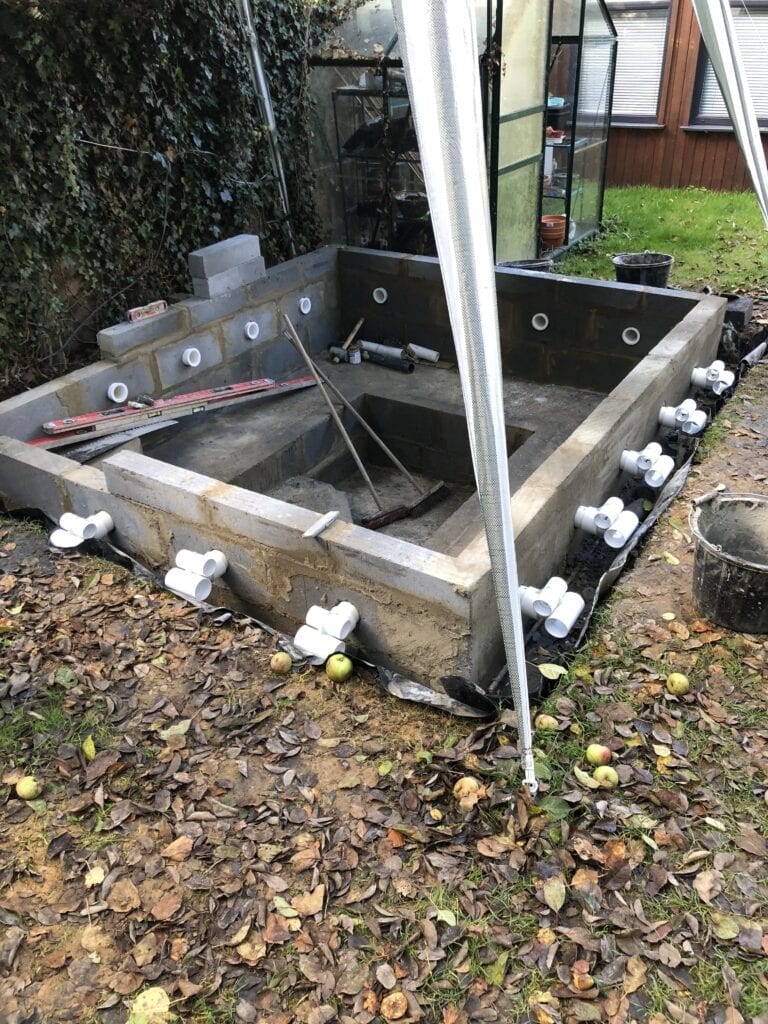
How do Gunite Bodies Work?
The “gunite jet system” comes in lots of different parts that need to be put together. The part that I didn’t understand was that the gunite system mixes air and water to give a stronger jet. There is a bit of physics involved here. I’m no physics expert so I’ll explain it in terms that I understand myself. I was under the impression that most of the power of the water jet came from the pump – this is not the case. The power of the jet comes from the mixing of air and water in the gunite body which in turn produces a stronger jet. There are two ways in which you can get air into the system. Firstly is by using “Venturi” vents. The Venturi concept is where water moving across an opening at speed will draw air into the system. This is why you see on some plastic shell tubs vents that can be opened and closed to adjust the jet strength. The other option and the method that I opted for was to go for a separate blower. Think “hair dryer” – it blows warm air through the pipes to mix with the water in the gunite bodies. Don’t be under any illusion that there is any significant heat generated by the blower that will make any difference to the overall temperature of your water – it will not. It will however give you some nice bubbly jets – exactly what we are looking for.
Looking closer at the plumbing, there are actually two sets of pipes that run around your hot tub. The first is for the air and the second is for the water. They are separate and they only mix in the gunite bodies before they hit the jets.
The gunite systems are made up of a Gunite body which is concreted into the hut tub. In our build of breeze block, you need a large bore drill to cut the holes in the cinder block. I managed it with a good quality hammer drill but you can hire specialist bore drills if you wish to make the job easier. Once these bodies are concreted in, they are ready for the piping. They will take an air feed (from the blower) on the rear of the unit and underneath, a water feed from the pump. Inside the gunite jet, there is an additional water pipe which screws into the body and had the jet housing attached to the end. All these are separate components that need cementing together with pvc cement. The Jet (you can decide the style later on) can then be pushed into place and interchanges if you so wish. The jet body is where the water and the air mix to give a more powerful jet.
As we are mixing water and air, we have to make sure that we have a one-way valve before the blower so that it is not possible for any water to get into the blower as that would trip your electricity supply and damage your blower, so you dont want that.
Think about final thickness of tiles. This was an area that I didn’t get quite right with the Gunite Bodies. In some of my jets I left too much room so they stick out a little. Not enough that people notice but being the perfectionist, I know. I also had a couple of them that were too tight which presents a bit of a challenge when you are trying to fit the jet bodies into the unite bodies. You end up with a gap which means that air escapes from behind the jet instead of being pushed through the jet in its entirety. Its not game over by any stretch of the imagination, but if you can get this right and allow the right amount of space between the wall and the unit body, allowing for the tile then you should have a very nice flush finish at the end.
Make sure your gunite bodies are perpendicular to the walls. Another mistake that I made with the gnat bodies was that they were not cemented into the blocks totally perpendicular so that means when you put your jets in, they dont sit flush to the tiles. Again, mine are not at an angle that is noticeable, but I know they are not 100%.
Jet Considerations
How many jets are you going to opt for? This may seem like a simple question but it does affect a few things. Firstly, you have to make sure that your pump is going to be powerful enough to push the water through the jets. Again, there is some physics here but explained simply, the more jets you have, the less force there is as the same amount of force has to spread across all the jets. Rule of thumb from what I read on the pump front is that a 3hp pump can cope with up to 20 jets. I have a 3hp pump and I am using 15. There is plenty of power from the jets so I would say that adding a few more would not have made a big different to the power of each jet.
Where are you going to position your jets? The shop bought tubs have jets all over the place and lots of them. They are not as powerful as the gunite jets but they give the same result. What I did was placed the jets so that they would be in the middle of my back when I was sat on the seat and they are in a uniform line all around the tub. The number and position of the jets is going to affect your plumbing. The more jets and the more ambitious the layout, the more difficult the plumbing.
To determine whether you should include jets in your hot tub, it ultimately comes down to personal preference. Some people may view the jets as an essential part of the hot tub experience, while others may be content with a simple soaking tub without jets. If you are considering building a hot tub, you may want to consider whether you want to make it as enjoyable and immersive as possible by including jets. However, it’s important to note that even if you choose not to include jets, you will still need some way for the hot water to circulate and be returned to the tub, such as hot water returns. Swimming pool returns do not serve the same purpose as hot tub jets.
Jets in DIY hot tubs that are built with block, concrete, or ICF materials are different from those found in plastic shell hot tubs. These types of jets, known as Gunite Jet Bodies, are unique to DIY hot tubs and cannot be interchanged with jets from plastic shell hot tubs or other manufacturers.
In contrast, jets in stock tank hot tubs or IBTL tubs are similar to those found in plastic shell hot tubs and may be interchangeable with those from the same manufacturer and series.
Hot tub jets work by mixing air and water and then directing the mixture into the hot tub. The flow and intensity of the jets can be controlled by adjusting the amount of air and water in the mixture and/or by turning the face of the jet. There are different types of jets available, including directional, roto, twin roto, and massage jets. However, it is important to note that jets can only be interchanged with those from the same manufacturer and series, as they have specific fittings that are not compatible with other brands or models.
The number of jets in a DIY hot tub depends on the flow rates of the pump. In general, DIY hot tubs have a smaller number of more powerful jets compared to plastic shell hot tubs, which may have hundreds of jets.
The flow rate of a jet pump is important to consider when determining the number of jets in a hot tub. For example, a 3 horsepower jet pump may have a flow rate of 200 gallons per minute at full power, but this can be reduced by factors such as bends, twists, fittings, and distance from the control room.
If each jet requires a flow rate of 10 gallons per minute to operate, a 3 horsepower pump with a flow rate of 200 gallons per minute could support 20 jets. To add more jets, it may be necessary to install a second pump. The arrangement of jets in a hot tub is flexible and can be customized to create different experiences in different seating positions, as long as the physical size of the jets and their bodies is taken into consideration.
Pipe Layout
At this point, you really need to have decided where your “control room” is going to be as you need to work on the pipe layout. If you remember, we said that the concept of the hot tub plumbing is quite simple. Water is drawn in through the skimmer and through the bottom two inlets pushed through the pump and back out through the jets. What you are trying to do with the jets is get the most power out of them. Again, I am sure that there is some physics that can be used to explain this, but to explain it in a way that I understand it, two shorter runs from the pump creates more pressure than a single run. Also two terminated pipe runs create more pressure than loop. As my tub is square and if you are stood facing it, I have the “control room” to the left front. My pipe runs split almost straight off the pump and they run down each side to meet, but not connect, in the top right hand corner. As we are going to be mixing the air and water at each jet, you are running two sets of pipes and they are different sizes.
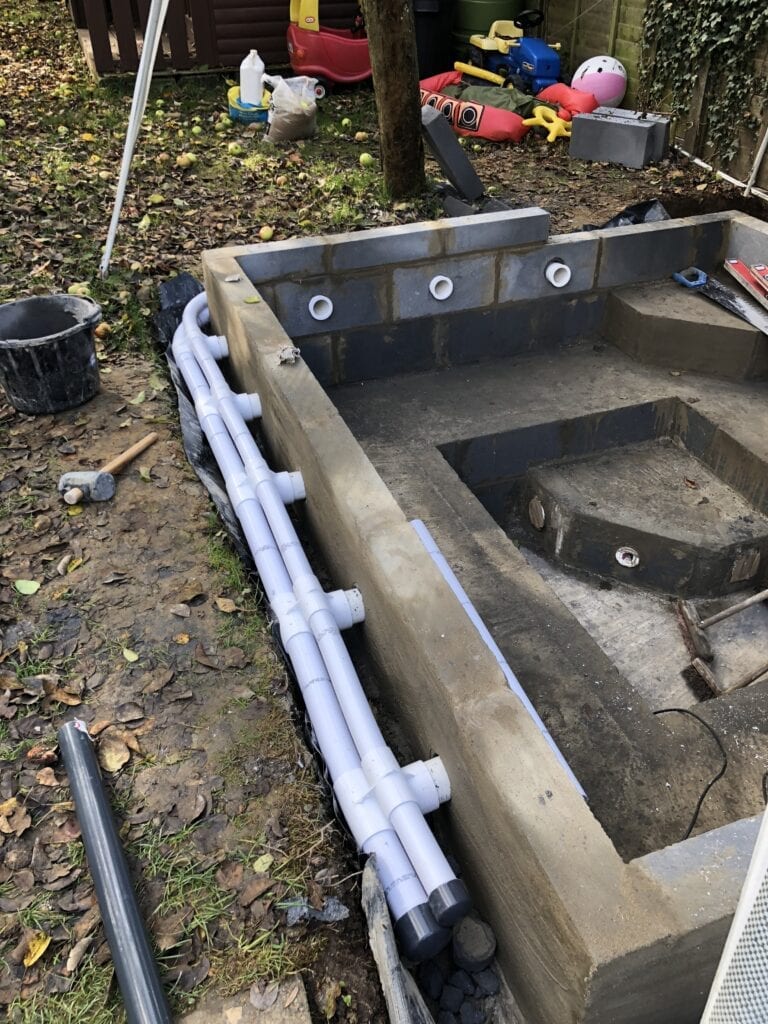
Types of Pipe
Pipes come in all shapes and sizes however with hot tubs, there are two sizes and two types. Firstly, there is rigid pipe and flexible pipe.
Now, do not kid yourself here as the “flexible pipe” is not flexible! Yes, you can bend it a little but is very hard and you will not be tying any knots in it.
This was a mistake that I made as my life would have been made easier if I had used some 90 degree junctions rather than trying to bend pipe. I had flexible bent pipes coming up through the steps from the bottom drains. I was trying to minimise joints as I thought that more joints would potentially mean more leaks. However, I was wrong on this as the pipe and connectors are so well made that an almost perfect joint is made each time with plenty of PVC pipe cement you will be all set.
Keeping the pipe neat and running parallel with good joints leads to lowering the probability of leaks. In my case, I knew exactly where the first leak was going to be as I ended up with an overly complicated joint on a funny angle that I couldn’t quite get to in the “control room”. Low and behold, when I filled up that was the first leaking point. I’ll talk later about what I used to fix leaks as I tried a few products and they didn’t work. OK, so back to our flexible pipes. These pipes are pressure rated so they are not the same as household plumbing pipes.
I used Waterway pipes in my construction (again one of those American brands) and they are really well made pieces of kit. There was also pretty much every combination of connector, bush or corner piece that I could think of. The pipes went together and felt so solid and well made I would definitely recommend Waterway pipes. I’m sure other brands are just as good but I only have my own experience to draw from on this point.
I mentioned that there is also rigid pipe available. I’ve no evidence for this but my thought was that if the pipe was flexible then it would be able to cope a little better with the pressure and would be less likely to pop out of a joint, so I opted for flexible. Its a little bit more expensive but in the whole bigger picture of cost, it is not going to break the bank.
Hot tub pipes, as well as being pressure rated are a specific size. Water pipes are 2” in diameter and air pipes are 1.5”. This is different from swimming pools. Also, something to note here is that an imperial 2” pipe is NOT the same as a 53mm metric pipe. At first glance it would look as if they are as it is hard to see the difference. However, there is a difference of a millimetre and a bit.
This does make a difference when you are trying to make water tight joints that are going to hold under signigicant pressure. Make sure that the parts that you buy all match. With Waterway what I will say is that they do have adaptors to take you from 53mm pipe back to the 2” as I used a couple of them on the skimmer. I’ll talk about this next.
I was a little confused on the types of pipe that I should be using. What was the difference between Schedule 40 and schedule 80 pipes? Schedule 40 and schedule 80 pipes are types of plastic pipes that are used for different purposes.
Schedule 40 pipes are thinner and less durable than schedule 80 pipes. They are typically used for drainage, water supply, and general plumbing applications like pools and hot tubs. Schedule 40 pipes are made from a variety of materials, including PVC (polyvinyl chloride), CPVC (chlorinated polyvinyl chloride), and ABS (acrylonitrile-butadiene-styrene).
Schedule 80 pipes are thicker and more durable than schedule 40 pipes. They are typically used for high-pressure applications, such as in steam systems and fuel lines, as well as in chemical processing plants and wastewater treatment facilities. Schedule 80 pipes are also made from a variety of materials, including PVC, CPVC, and ABS. This is a bit of an overkill for building DIY Hot Tubs.
The main difference between schedule 40 and schedule 80 pipes is the thickness of the wall of the pipe. Schedule 80 pipes have walls that are twice as thick as those of schedule 40 pipes, making them stronger and more resistant to pressure. This also means that schedule 80 pipes are heavier and more expensive than schedule 40 pipes.
It’s important to choose the right type of pipe for your specific application to ensure that it can handle the pressure and temperature conditions it will be subjected to. In general, schedule 80 pipes are more suitable for high-pressure and high-temperature applications, while schedule 40 pipes are suitable for lower-pressure and lower-temperature applications such as our DIY Hot Tubs.
Top Tip to Make Pipe a little more workable!
To enhance the workability of plastic pipes, several techniques can be employed to make the material more pliable and easier to manipulate. One effective method is to heat the plastic pipe to a specific temperature range, typically within the manufacturer’s recommended guidelines. Heating the pipe softens the plastic, making it more malleable and less prone to cracking or breaking during bending or shaping processes.
Furthermore, taking precautionary measures to prevent overheating or overbending the plastic pipe is crucial. Overheating can cause the material to become brittle or lose its structural integrity, resulting in cracks or deformities. Similarly, excessive bending can strain the plastic, leading to weakened areas or kinks. Adhering to recommended temperature limits and using gradual, controlled bending techniques can help maintain the integrity of the pipe while maximizing workability.
I have found that using hot water to heat the pipe indirectly works well and can make it a lot easier to use.
The Skimmer
Now that you have decided how many jets you are having, where they are going and how you are going to plumb them in, you now need to consider the Skimmer’s position. This is a little more tricky than you might think. Firstly, you want to have the skimmer as close to your pump in the “Control Room” as possible. Secondly, the height of the Skimmer is going to dictate the water level. The ‘perfect’ final water level in the hot tub is that it comes half way up the skimmer. This is to allow any debris to flow freely into it where larger pieces of debris, or in my case, usually the kids toys, end up in the basket. Smaller leaves and bits pass through and are caught in your filter.

The other thing that you have the consider with your skimmer is the final top position of the access grill. This was something that I got a little bit wrong on two cases. Firstly, I under estimated the overall height of the skimmer when I had added a 90 degree bend on the bottom to direct water towards my pump. For me, this meant getting out the hammer drill and having to break another 20cm of concrete that I had laid so that it would fit. Secondly, I also got the height a little wrong so it doesn’t sit flush with the deck that I have put in afterwards. It wasn’t a big deal as I made a cover to fit but in a perfect world, it would have been flush.
The size of the skimmer that you choose is going to be dictated by the size and volume of water you are going to have in your tub. Check with the manufacturer for what they suggest. I have 2800 litres which has meant that I needed to opt for a swimming pool skimmer. I went with a brand and choose the Certakin brand as they are the ones that you regularly find in swimming pools. My tub was too large to consider a hot tub one. This posed a couple of difficulties. One was that it was actually on the metric sized 53mm pipe and I was of course on the 2” water. A bush and 90 degree bend from Waterway sorted that out. The next thing was avoiding the “swimming pool tax” as I like to call it. By shopping around on the internet I managed to save about 90 pounds just by googling the model. This was even better than the trade deal that I was getting from John the pool man. He was just not able to compete on price on that part so it is always worth shopping around.
Pumps, Blowers, Filters & Ozone for your DIY Hot Tub
We’re now getting to the expensive components of your Hot Tub so it is worth taking some time to get all of this right. Let’s start with looking at pumps. Once you have decided how many jets you are going to have, you can then make a decision on the pump that you need. I went with 15 jets so opted for a single 3HP dual speed pump so this pump will take care of the circulation of the water as well as powering the jets. If you are going for multiple pumps, you need to make sure that the Spa pack that you choose can deal with them too. Unless you have some real grand design I would suggest going for a single dual speed pump. It makes life simple and the plumbing is easier. What I can say that for my 2.6 x 2.5m Hot Tub, 2800 litres of water and 15 jets, the 3HP pump is more than sufficient. I opted for a Waterway model as this was well priced and a good brand.
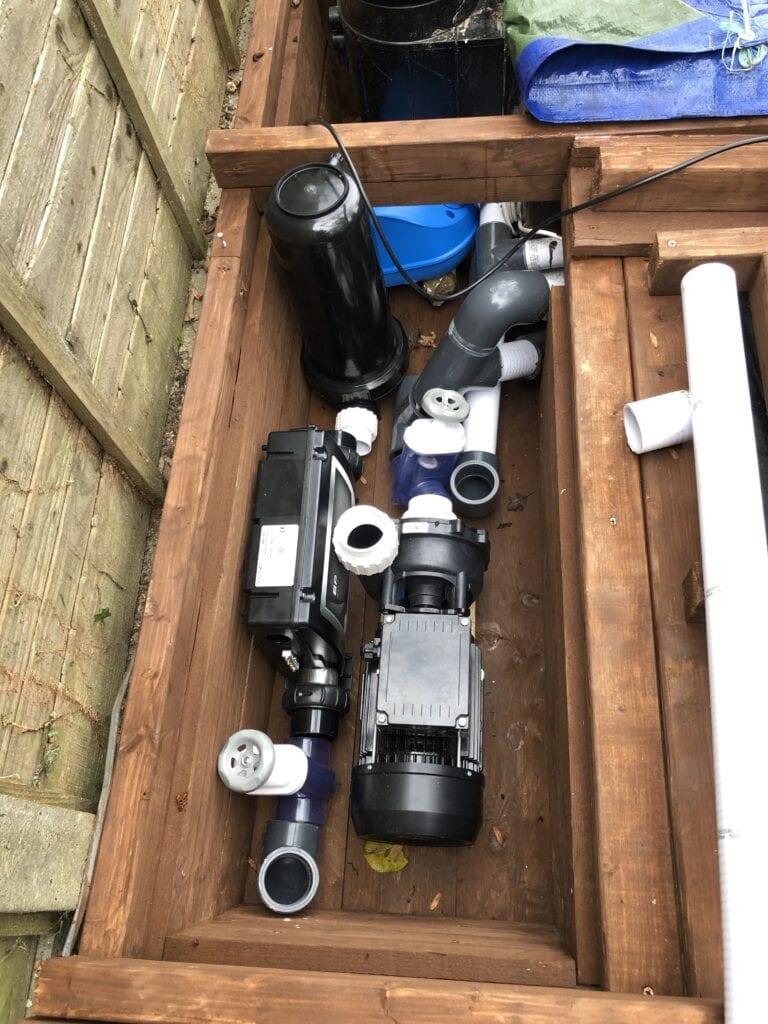
Blowers. I did think that I would try and not use a blower and just use a Venturi system but I am glad that I didn’t the blower makes all the difference. There are different types of blower as you would expect. I opted for a 500W single speed blower that does do some heating of the air too. I wont describe the analogy that I received from John on the benefits of blower heating the water, but I’ll summarise in that it will not make any difference at all. What it will do is create lots of bubbles for you – perfect! If you are looking at a multi-speed blower again you have to match this with a Spa Pack that is going to be able to cope with it. As you would expect, the more features you are looking for, the more they cost.
The filter. This is essential to keeping that lovely large body of water nice and clear of debris and bits. With the filter, these are sold by how many litres an hour can flow through it and also the size of the body of water you plan to filter. The bigger your hot tub, the bigger the filter required. Makes sense really. Filters are made up of four elements, Cores, Media (Filtration Fabric), Bands, and End Caps. What you want to do is make sure that the filter has a properly designed core that maximises the filtration area. This in turn increases the flow and it will also create a uniform flow through the entire cartridge. What this means is that you will in effect increase its life and the cleanliness of your Hot Tub water. Top tip, don’t skimp and buy cheap here. Buy a good quality filter from a reputable manufacturer.
When you are choosing your filter, you need to be mindful of the pump that you will be using too. I choose a Waterway filter and a 50sqm one. That matched up with the size of my Hot Tub (7.5ft x 6.2ft approx) 46.5sqft. So on those calculations I am at the upper limit of the filter really once you allow a little bit for water head.
However, one of the features of the Waterway filter that I chose was that it had an auto bypass for high pressure. This means that under regular circulation pressure it will filter my tub. When the 3hp pump kicks in and the pressure increases, it will bypass some of the the filtration to increase the flow and stop the potential damage to my pump.
From what I have found online, over specifying your filter is not a bad thing and it can reduce potential expensive damage to your pump if the pump us put under undue pressure due to a restriction of flow through the system. So, if you are not sure, then you can go up to the next size if you need to.
The Ozone or Ozonator was the part that confused me and also is the only part that continues not to to work on my Hot Tub; let me explain. What the ozonator does is generate ozone gas that is drawn into the water through a Venturi effect in your plumbing. Ozone kills all the nasty stuff in your hot tub and is great for keeping your hot tub clear and disease free. The mistake that I made with the ozonator was that the way I plumbed it in made that there was not enough flow and thus Venturi draw for the ozone to be drawn into the water when the tub is just filtering – ozone doesn’t work when the jets are running. If you are going to use an ozonator then you have to plan for this in your plumbing and also make sure that you are going to have enough water flow to draw the ozone into the water. I got this bit all wrong. Have a look at the diagrams below to see why. Yes, I can fix this but I just haven’t got round to it. The tub works just fine without it and making sure the rest of the chemicals are all balanced I’m sure I have disease free water too.
The Spa Pack
The Spa Pack is really the control centre for your Hot Tub. It is the part that controls the blower, the heater, the pump the lights and the ozone too. As you can imagine, it is pretty important. There are a few things that you need to consider when you are selecting your Spa Pack. Firstly, is the heating element and the power of the heater. The heater that you need is going to be dictated by how much water you are looking to heat. I’ll use my own example here and I have 2800 litres of water that I need to heat. When I was designed the original tub and in the planning stage, I was designing it to be slightly bigger than I have now and I calculated that I would have 4000 litres of water. John the pool man was suggesting as I have mentioned earlier a custom built heater that would be 12KW to cope with the volume. You do not want to do this at all. Its incredibly expensive, I think it was in the region of £9000 just for the heater and then there is the running costs on top. Not to mention time to heat.
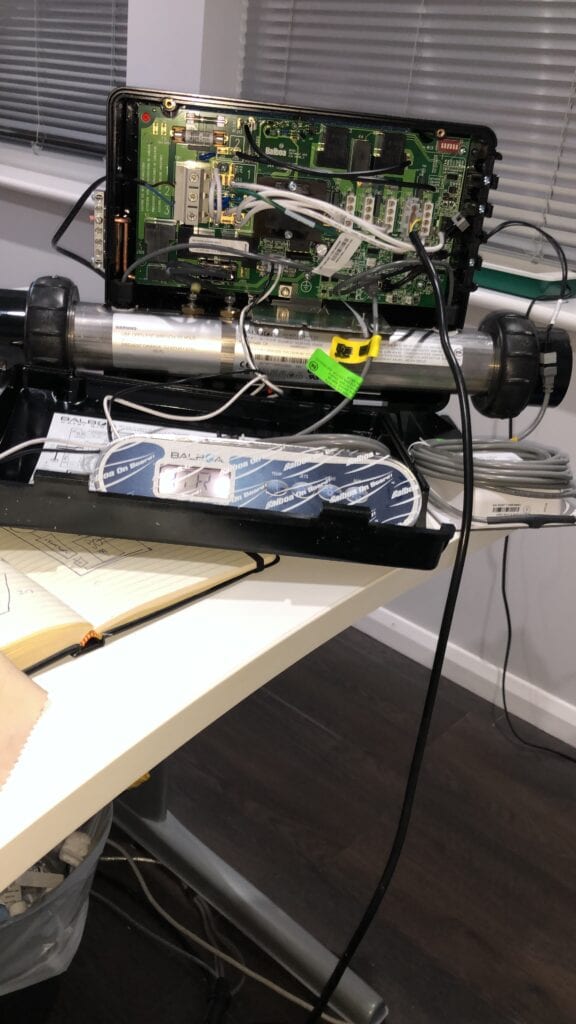
My tub at 2800 litres is quite large and it does take time to heat. I opted for a 3KW heater and from cold, it takes 40 hours to heat. To recover, which is after you have used it, how much temperature you loose, I’m looking at 0.5 degrees an hour. When I’m using the tub, if I’m in for an hour, I’ll loose about 3 degrees so it is a further 6 hours to heat it back to temperature.
Now, if I wanted to speed this up, I could have put an independent thermostatically controlled slave heater in and double the size to 6KW of heat which would in turn speed things up. I think fluid dynamics is not a straight line so I will not say that it would be twice as quick but it would speed things up. These are the again decisions you need to make at design stage or leave enough space at design stage so you can retro fit if you need. I’m fine with the 3KW and now that I know how long things take I can plan accordingly.
After the heater portion of the Spa Pack, the next decision that you need to make is whether the spa pack is able to deal with the individual components you have selected. For example, if you want a separate circulation pump and a pump for the jets, then you need the ‘slots’ on the Spa Pack to plug them in. Blowers, Ozone, all need to be plugged into the spa pack so it is very much a case of trawling through spec sheets to make sure that it is capable of what you want.
For me, the absolute must was WIFI control. I love gadgets in general but from a practical side I wanted to be able to control the spa from afar. Set it heating up if we are away and monitor the temperature. I knew that I wanted a Balboa Spa Pack and opted for the WIFI enabled BP601.For the topside controls, this really depends what you want. I know that some people now don’t bother with them and just use the WIFI. I however did want some control just in case the App or WIFI had any issues and went for the TP400 a simple but does the job control. I can’t stress enough to look at the specifications as I’ll explain shortly how my not paying attention to specs has cost me in the wallet.
Build a Hot Tub – Lights
Having a light in the hot tub is must. It adds to the atmosphere, means you can use it at night and it really looks the part too. Out of all the parts of my build, I expected the light to be the easiest. Yes, it was simple to fit, but has caused me some problems which I will come on to. Because of the size, I wanted to go for a swimming pool sized light. I chose a large LED multi-coloured one which I thought would look great and it does by the way but not without causing me problems.
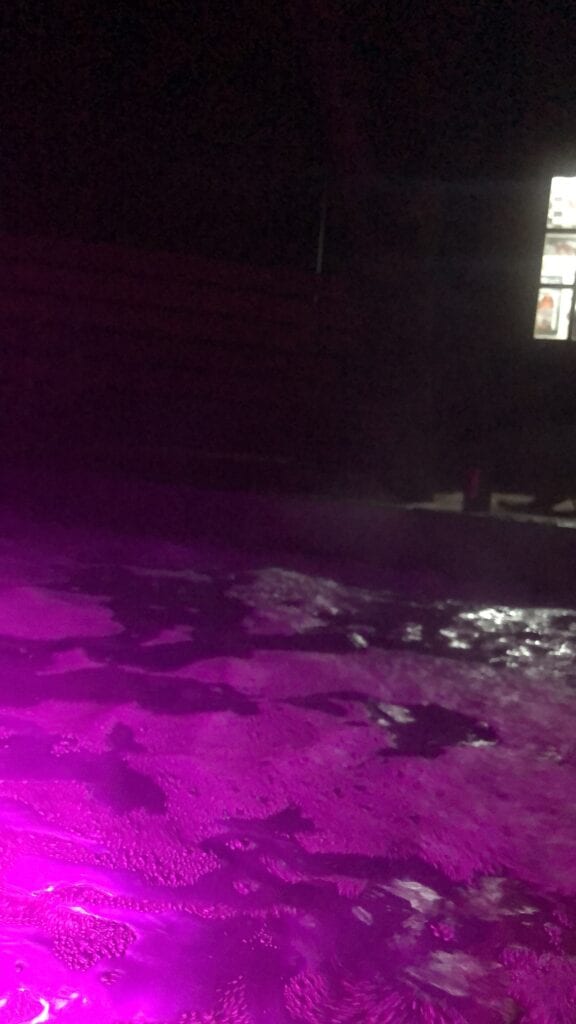
Fitting the light is pretty straight forward. The cable sits inside a 1/5” solid pipe and then the light module slots in and twists into place. There are just a neutral and live cable that need to be connected. The cabling needs to go in at a very early stage, eg before you are putting in blocks and once your blocks and concrete are in, that is it.
The problem I had was I wanted to control a swimming pool light from the Spa (Hot Tub) control pack. Straight away there should have been alarm bells ringing. I also noticed that the output from the Spa Pack was 10vAV and the light was 12vAV. I thought, that is fine, it will just tun a little dimmer than it would at 12V, no problem. I hooked all the kit up in my office testing it and yes, it worked great. Not so great as I found out 3 months after the build was complete.
So here I am, three months down the line from when I completed my hot tub build. My aim was to have the build done for Christmas as I had just finished it, December 22. Picture the scene. Tub had been heating up and I’d been closely monitoring its progress for couple of days. I’d had problems previously that week with a fuse blowing but thought it was teething problems, ordered new fuses and it was ok so I thought. I have the wife and two kids all excited and the kids had already jumped in. I turn on the buttons one by one, jets, pump, lights, blower, it works for 5 seconds then totally dies again, the fuse had gone, again. I’d bought a couple of spares just incase which over the next few minutes, I went through. I put a slightly larger fuse in and boom, we were in business. I thought I must be on the limit of something or was it a batch of dodgy fuses – who knows but I was working. Not an ideal start but we had the tub for Christmas.
Works perfectly for 6 weeks then suddenly, one Saturday night the whole thing is dead again. Fuse I think, no problem, didn’t bother putting the meter on it just quickly swapped it – nothing. Oh dear, what have I done. I pull the PCB out of the Spa Pack the next day and get a meter on it checking what is working and what is not – I’d blower the transformer as there was no 10V supply but 250V was ok. How have I managed that I wondered – dodgy board I thought. I return it under warranty and to speed things up, I buy a new PCB (which are not cheap) but I knew I was getting it back so not a problem, thats what credit cards are for.
I fit the new PCB, heat the tub up, works fine for 30 minutes then dies again – another transformer gone! How am I going to explain this one under warranty? At time of writing I am still working on that just to let you know. Now, what am I doing to cause this? The wife is suggesting I get an electrician in to check things (which I don’t like the idea of because I’m that guy) and I’m scratching my head. I’ve a couple of very knowledgable friends who work in the electronics industry so it was time to enlist the big guns. We started to brainstorm some ideas about what it could be. Went through the components one by one and the only thing that stuck out was the light. Surely a light was not causing all these issues. Well, not the 3rd PCB is in and the light has subsequently been re-wired so it is not on the Spa Pack circuit now, time will tell.
What we found was yes, the light works on 10V, but it is a 27W light. 27W lights at 10V draw 2.7A of current in a totally efficient circuit. What can the Spa Pack output, 10V and 1A – DOH! Why on earth had I not checked this. I’m trying to pull three times the current out of the Spa Pack no wonder it is giving up the ghost. Why did it work for 6 weeks, well, we think that when it is on colour fade mode which is what I had it on pretty much straight away, it was drawing less but right on the limit – so much so the transformer just burnt out. The second PCB, the light was on bright white, most current draw so it gave up the ghost immediately.
Moral of the story, check, double check and triple check spec sheets and that will save you time, stress and a lot of money – I’m out over five hundred quid until I get these through as RMA, if I can! Hope the manufacturer is not reading this.
The “Control Room” for your DIY Hot Tub
The “Control Room” as I call it is where you need to house your pump, Spa Pack and filter. If you decide to go with them, the Ozone and the blower will also be housed in this area. The first thing that I would say here is measure up the space that you think you need for these components and then double it! This is one of the things that I would change on my own tub if I came to build it again, I would give myself more space. The problem that I had was firstly, it was too small so I needed to increase the size mid-build, not ideal! Secondly, it is still a little tight and not deep enough for the filter. I have my filter tilted on a slight angle so that it fits in and the plumbing that comes in from the bottom drains of the tub are also on a strange angle when they attach to the pump inlet. If I had more space, this would have made things easier. I have the space on the deck near the tub, I think at that stage of the build, I’d dimply had enough of digging! I mentioned earlier that I had to dig by hand so after a couple fo weeks of lugging earth around, i was done and rushed that part a little.
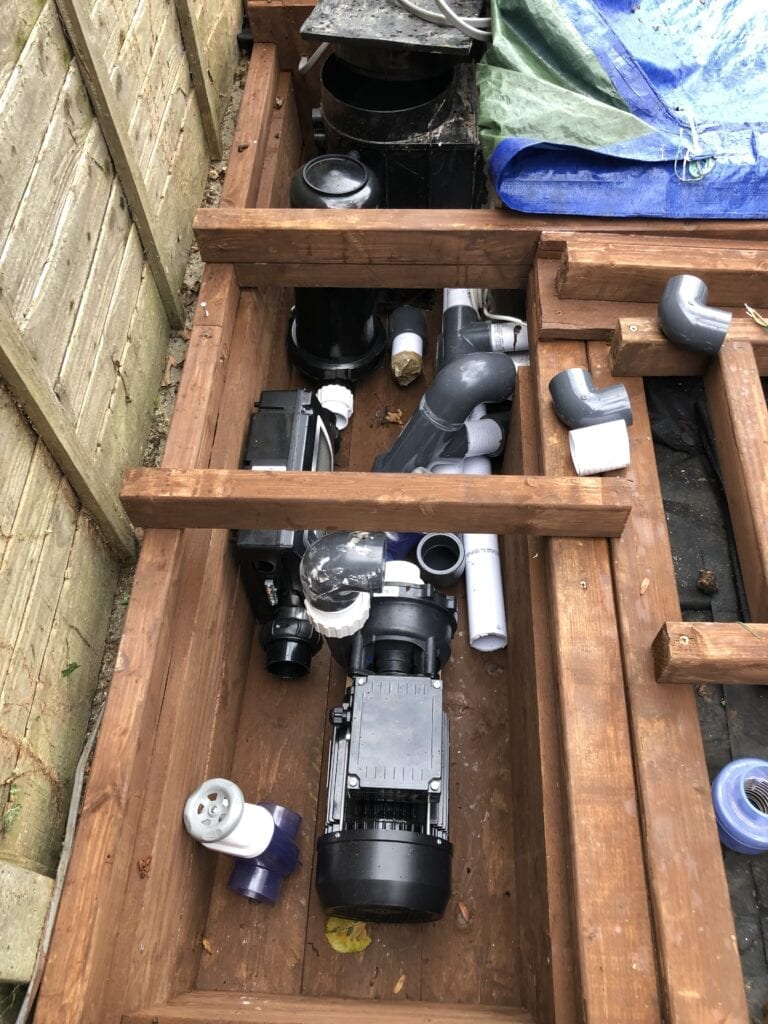
The next thing for the “Control Room” is make sure it has a drain! You don’t want this to fill up with water (believe you me, I’ve don’t it and it is not pretty) The expensive components are meant to stay dry – fact! You need to make sure that your Control Room can drain if water does escape, which it will, when you change the filter or when you remove the pump for a service. It needs to drain away. I put a piece of pipe in the bottom of mine so when I lined it with concrete, I removed the pipe once it was dry and there was a hole onto the dirt for the water to drain away. I know some people also put in a water pump with a floatation switch into the control room so if it does fill up, the pump will kick in. This is fine, but it depends just how quick things fill up.
I said that I made some mistakes on my build that this website would help you avoid and this was one of them. Six weeks following the “launch” of the hot tub, despite my electrical issues, I thought things were going well. One Sunday afternoon whilst watching the F1 (Yes, I have installed a TV but we’ll come onto this) suddenly the power went. Having had problems with the light already, I thought it was that again. The MCB had tripped in my garage so I turned it back on, booted up the spa pack and as soon as the pump kicked in, it tripped. I thought that I had better have a look what was going on in the Control Room to find that it was full to the brim with water. “Oh S£££” I think was my reaction as I thought that the block work on the tub had cracked and it was a leak. After draining the Control Room and starting to faulty find, much to the amusement of my daughter when I was drenched by the pipe that had come loose – somehow, I had managed to leave a dry joint and not glued in that section – a time bomb waiting to happen.
What is the point to this story I hear you ask. Well, drainage of your control room is key as if you do flood it, like I did, you want it to empty. Secondly, even if I had installed a “flood”pump, because the pipe came loose and my 3HP pump on full speed was essentially filling the Control Room, my money saving tip here would be don’t bother. In my case, a secondary “flood pump” would have been useless because it would not have emptied the Control Room quick enough. Did I damage anything? No, luckily, I did not but it took a lot of time to take things apart, drain them of water and dry them out. Even the pump, I had to disassemble the pump right down to the coil and tip out the water from the ‘dry end’ not ideal. I was lucky.
Build a Hot Tub – Electrics
Electrics are kind of key to your build. They are also somewhat difficult. If you are building your own Tub, the chances of being able to plug in a 13Amp extension onto your house wiring and hope it will work and slim to none – you need some dedicated electrics. I should also point out here that the work should be dome by a qualified electrician.
The first thing that you are going to need is a dedicated supply down to your Hot Tub in your garden. Depending where that is and what your existing electrics looks like determines the exact requirements. I’ll talk a little about what I did.
My house is a 1970s build and the wiring is not the best to say the least. I knew I needed a dedicated supply. What does that mean? Well, in my case, the control board where you find all the fuses for the lights, your sockets, the cooker etc, was full. This meant that I needed to take a feed off the main supply into a new control box with its own MCB or Master Circuit Breaker.
If you haven’t done any electrics before, I would leave the whole thing to an electrician. Where electrics are concerned and certainly in the case of a Hot Tub, the important thing is the current available rather than the voltage. Yes, voltage is important, but the current even more so. The basics of electrics are that an average house supply can deliver somewhere in the region of 100A at any one time. This relies on a few things. Firstly, the correct fuses being installed as your sockets for example will be on a 20A fuse as they are only meant to be drawing 13A max and your lighting on a 10A fuse as they are only meant to be drawing around 5A. A Hot Tub when running on full can draw anything up to 45-50A so it needs a lot of current. Secondly, in addition to the correct fuses, you need the correct cable. More current needs thicker wires as you don’t want cables getting hot!
The basic rule here is that you are going to need 6mm twin and earth to deliver the amount of current your Hot Tub is going to need. Now, if you are running this down the garden, to comply with regulations, this either needs to be armoured cable that is buried to a depth or around a meter, or fixed to a wall. You should not be running grey electrical cable down your garden, this is dangerous as you can put a spade through it or your kids could cut into it with their toys as they brush past. You get my point here. So, in summary, 6mm, twin and earth, armoured, on a dedicated feed, probably around a 55-60A MCB installed by an electrician and you should be good to go. You should also have a security switch to isolate the Hot Tub within 5ft of the tub too. A lot to consider.
If you don’t have the current available, or the wrong fuses, this is going to cause trouble. So exactly how much current do you need. The calculations are quite simple and it is a case of going back to the spec sheets or manufactures specifications so that you can add them up.
Everything that is going to be connected to your Hot Tub that is electrical should be taken into account and added to your list. It should look something like this
Pump 12.5A (on high)
Blower 3.1A
Spa Pack 12.5A
Spa Lights 3A
AV 5A
Decking Lights 1A
Total 37A
In addition to the above, as I have a few more things connected to my supply, like an office which is heated and has air conditioning, I needed a full 60A supply for my tub. The electricity supplier likes me a lot 😉
The MCB is also important as this will protect you from electrocution. Sounds serious and it is. For example, when I flooded my control room, if my MCB was not working properly, I would have been electrocuted. As it happened, as soon as the water entered into the blower as this was the lowest running component, it tripped the MCB and made it safe – phew!
It sounds basic stuff, but water and electric don’t mix so it is worth spending the money and making sure that a qualified electrician does the work so your build is safe.
Breaking Ground
This is where the “fun” really begins. You’ve been planning for what seems like an eternity wanted to get started so it is now time to break ground. For me, this was the hard part. As I explained, due to access to my back garden and where I wanted to put the Tub, there was no way that I could actually get a JCB Digger in to help so it had to be done by hand. It was back breaking stuff.
I did however, end up buying a mechanical breaking drill. This made life a lot easier. You can rent them and the ones you rent are even bigger still. The problem that I had was that I was not sure how long it was going to take and I didn’t want to waste money on renting something that was not being used. So I bough a mid range one. It was a god send and made light work of the earth when I did hit the clay and rubble. I would highly recommend one if you are not able to get one of the mini JCBs. The digging took me about two weeks doing a few hours at in the evening and full days at the weekend. There was a lot of rubble and earth to move.
When you are designing how deep you need to go and sticking with your dimensions, make sure that you have allowed for the various layers of type1 hardcore and concrete to a reasonable thickness. The last thing you wan it seats that are too narrow or a Tub that is not deep enough.
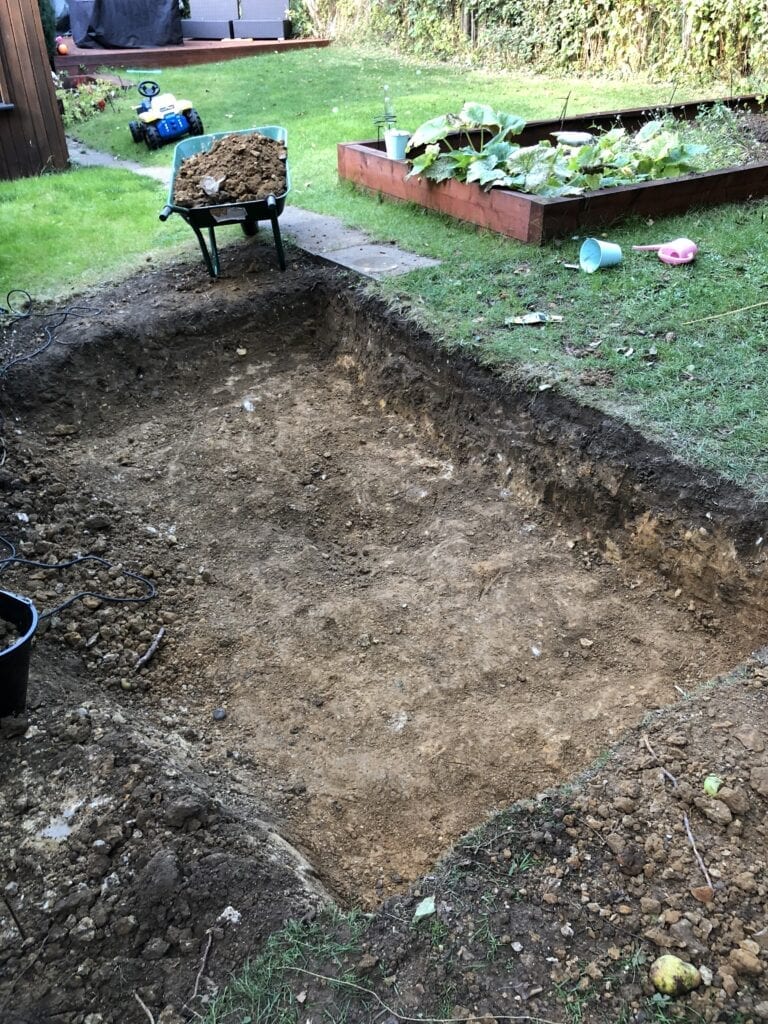
As I couldn’t get a digger round the corners of my garden either, I was doing all of this by hand. At this point, my back was hurting and the ground was getting harder so I open for the breaker. This was the best 200 GBP / 200 USD I have spent in ages! Made life so much easier.
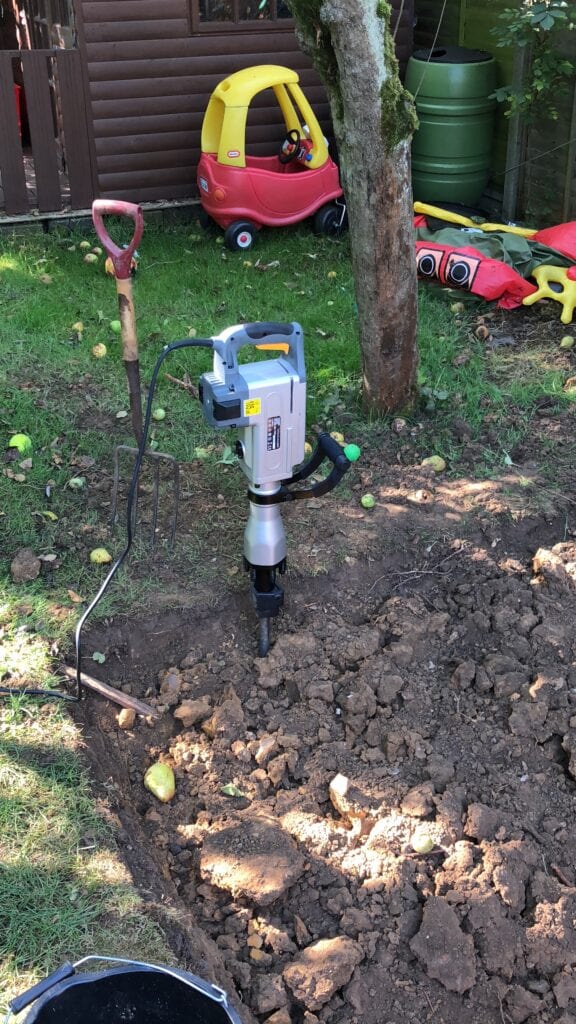
The Base
Being a competent DIY’er I had done some electrical work before so that didn’t concern me. The plumbing is “kitchen plumbing on steroids” so I wasn’t too worried about that. What did concern me was whether I could dig a hole and water proof it sufficiently so that it didn’t leak through the walls or through the floor.
My next concern was could I build a structure that was not going to give way under the pressure of the water. I had calculated that it was going to take about 2800 litres which is around 2.8 tonnes of weight – certainly not light. Therefore, I knew I needed concrete and lots of it.
Once I was down to depth (which was a huge milestone for me as my back was killing me and I was fed up of digging) it was time for the type1 gravel to be dropped in. Basically, I put around 6-7cm, or 2” of gravel and then compacted it. You could hire a “wacker” to do this, I just used a heavy piece of timber and a sledge hammer. The whole point of the type 1 is that it can disperse the pressure of the concrete evenly helping it not to crack. Cracks equal leaks so you certainly don’t want these.
After I had put in the type 1, I decided I didn’t want to take any chances so bought a large PVC thick pond liner. This was going to ensure that I didn’t have any leaks. I laid this over the gravel as it was going to take the concrete and hold in the water.
Next were the steel rebars that were held together with metal wire. You see these being used in building structures so I thought it made sense to put them into the build, strengthen the base and stop it cracking under pressure. I’m sure there are some builders out there that would say total overkill, but remember, I was worried about strength and leaks.
Now it was time to mix some concrete.
Mixing the concrete rather than digging a hole was a welcome change. However, what I didn’t realise was just how much concrete I was going to need. I’d looked at hiring a mixer which I would definitely recommend. I did say looked at hiring as I never actually got round to hiring one. The problem I had in my head was I wasn’t sure how long I was going to need it. At this point in my build it was early October so the weather was a bit unpredictable. What I didn’t want to do was hire the mixer and then let it sit unused for a week and have to pay for it. A bit tight? Perhaps! So, I was mixing wheelbarrow after wheelbarrow of concrete. I was mixing sand and cement at around 4 parts sand to 1 part cement. I was also making the mix not too stiff so it would pour ok and be a bit easier to level out. What I also did every step of the way was add lots of water proofing liquid agent. As I said, I wanted to make sure this big hole did not leak. Bit by bit I worked from the bottom up. I filled and had a level base, then it was time for some block work.
Block Work
I hadn’t laid blocks or bricks before but I thought I would give it a go. What I certainly am not going to win any prizes for was speed – I was very slow. Having seen the professionals do it when they were building my extension, I was very slow indeed. That said, it wasn’t a race so it didn’t really matter.
I made the mistake of not getting the base totally square. I was out by about 2cm which isn’t the end of the world but if I had spent a bit more time putting in guide lines, then I think I would have been spot on. The only real tip I have is take you time and check the level of each of the blocks as well as the continuous level of the course of blocks.
I mixed my mortar a little wetter than most as I knew I wanted it to last a bit longer as I was slow. Too wet and your heavy blocks dont sit well so this is something to consider too. If you start with a level base it makes life so much easier. The deepest part of the tub was not 100% level when I started laying the course of blocks. What this means is that you end up having to compensate to try and level things out.
By the time I came to the second layer, I was a bit better. I put in the guide lines and I was also starting on a level base so life was much much easier. When I finished, the top runs were perfectly square.
Mortar Mix
I was mixing the mortar by hand as I wasn’t sure how long it was going to take or how much time I had and because of the time of year, what the weather was going to do. This was back breaking stuff, not as bad as digging the hole, but it was hard work. That said, it was possible to mix in a wheelbarrow and I was mixing at a rate of around 4 to 5 parts sand to 1 part cement. I am sure there are some builders out there that would have a different opinion to this, or perhaps a more refined opinion for the different applications, but this ratio worked for me.
It was not too hard that it didn’t last and set too quickly and it was not too soft and watery either – it was just right. You should be able to pour it if you are backfilling, and make it a little stiffer if you are going to lay blocks with it – just makes life easier.
Don’t make it too hard or too soft as both affect strength of the mix.
What I was also doing with the mortar mix was adding water proofing agent and plenty of it each time. As you can probably guess whilst you are reading this, I was really worried about the Tub leaking! I took every precaution possible to make sure that it was not going to leak.
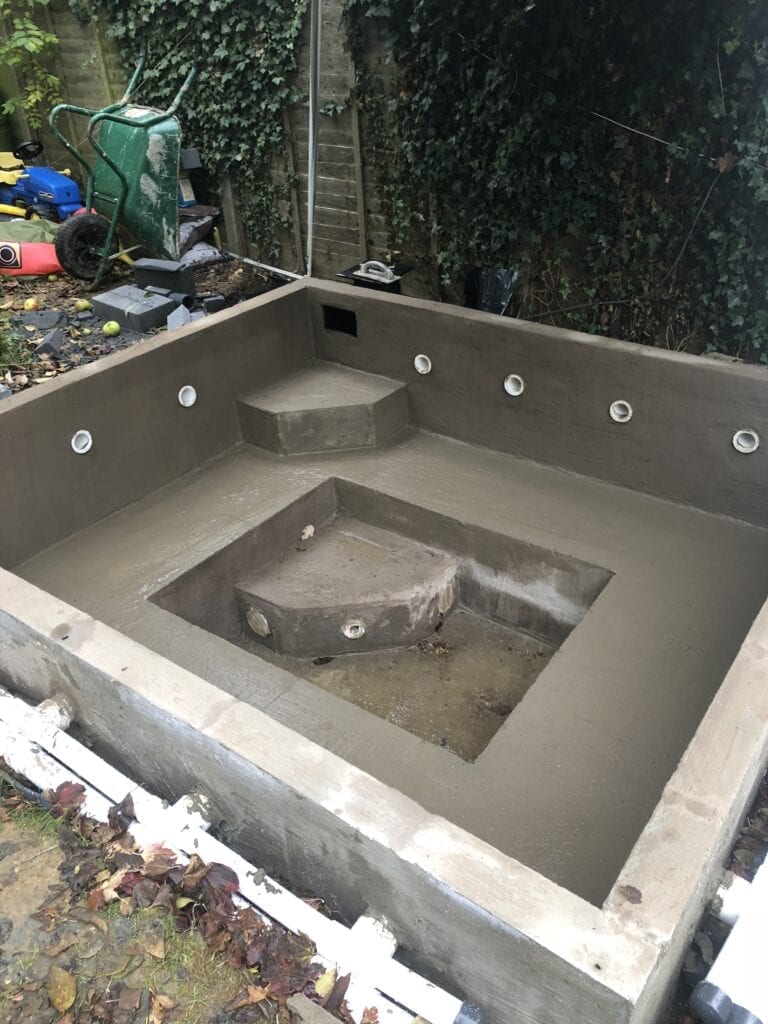
Hardness of blocks
Blocks seemed to come in different hardness offerings. This is for the amount of force they can withstand when you are building tall structures with lots of courses of blocks. Makes sense I guess and I am sure there is a proper explanation out there for what is what. I wasn’t sure exactly what I needed so went with a middle of the road 7N of hardness. Also, I didn’t think that I needed any more because I was only going up a couple of courses so there was not a lot of pressure on them. If anything, the pressure had to be on the sides coming from the water.
If I had the chance to build my DIY hot tub again, I would definitely opt for using hollow CMU (Concrete Masonry Unit) blocks with rebar inside. Structurally, this option offers several advantages over regular blocks.
Firstly, the hollow design of CMU blocks allows for the placement of reinforcement, such as rebar, inside the cavities. This reinforcement significantly enhances the strength and stability of the hot tub’s structure, providing increased durability and resistance to external forces.
The rebar acts as a reinforcing skeleton, preventing cracks and ensuring the longevity of the hot tub. Moreover, the hollow spaces in CMU blocks can be filled with insulating materials, such as foam, to enhance energy efficiency. This insulation helps to retain heat, keeping the water warmer for longer periods and reducing energy consumption.
Additionally, the uniform shape and size of CMU blocks allow for precise alignment and easy installation, resulting in a professional-looking finish. The modular nature of CMU blocks also provides flexibility in terms of customization and future modifications.
If any repairs or alterations are needed, it’s relatively straightforward to remove and replace individual blocks as required. Overall, opting for hollow CMU blocks with rebar inside offers a structurally superior solution for a DIY hot tub, ensuring strength, longevity, and energy efficiency, while also providing flexibility and ease of installation. Something for you to consider for sure!
How many?
This really depends on how big your project is. My Hot tub is 2.3m x 2.6m and I ran two courses on the lower part of the tub and 2.5 courses on the top section (back of the seat) this used roughly 100 blocks in total, I did have a few spare at the end. It’s a simple calculation, take the dimensions of your tub and divide them by the length of the blocks, simple really.
Top tip to make life easier for yourself, pick your dimensions so that you use as many full bricks as you can. The less you need to cut the better. Also, make sure that you order a few more than you need as if you are cutting them they can split. If you drop them, they shatter, so you do need to have some spares on hand.
Cutting them
Having the right tools for the job makes life a lot easier. I bought a block hand saw from Amazon for about 15 quid and it made mincemeat of the blocks when I needed to cut them. It was really easy and you just let the saw do the work. I was even cutting the final half course of block by splitting them into two which with the saw was an easy task. There were more expensive powered cutting disks and saws out there, but for the amount of cuts I was making, I didn’t think it was worth it.
Gunite Holes
Once you have your block walls in place, and they have had a couple of days to set properly, you need to be cutting some holes to slot in the Gunite bodies. These are pretty big holes so you are going to need a core drill bit. As I have said having the right tools for the job make life easier so if you want to really make life easier, go and hire a bore drill and the correct sized core drill bit, probably 2.5” wide. If you want to save yourself a bit of money as I did, then buy yourself a core drill bit online which are relatively inexpensive and use your power drill. This might seem like it is going to be easy but….The first thing is that the core drills do bounce around quite a bit until you have sunken the first 5mm. Getting that first 5mm in the right place is quite hard. So here is what I did. I took one of my spare blocks and measured the height that i wanted the jets to be – roughly in the middle of my back when i was sitting on the seat. Then I cut out a “u” shape with the block saw in the block. This was the right size so that I could then put the core drill bit through. This made life a lot easier when cutting the holes as there was a guide and holding the block in place with my foot, it steadied the core drill for those all important first 5mm. Yes, perhaps hiring a bore drill would have been easier, but I saved a bit of cash with this method.
Once I had all the holes drilled, it was time to drop the gunite bodies into place, and then cement them in. I took a bit of time to make sure that the holes were correctly filled as this is an obvious place for leaks to be. I wasn’t overly concerned as I planned to backfill over the gunite bodies and the pipes anyway. Firstly for strength and secondly for water proofing.
A top tip here is to fit the external pipes into the gunite bodies before you cement into place the bodies themselves. It is quite fiddly to get the pipes into the housings if the bodies are already fixed into place as they were in my case. If I did it again, I would definitely fit all the pipes first, then cement into place the bodies.
It is also important when you put the gunite bodies into place that they are totally perpendicular to the wall of clocks you have laid. If like in my case some of them are not, then your jets do not sit 100% flush onto the walls. Not a huge problem, but it is one of the things I would have taken more time to get right had I known that it was going to be a problem. Not a big issue in my case, but it is something that niggles in my mind as I know they are not 100% even if everyone else doesn’t realise when they use the tub.
Backfill of Concrete
I’d already come to the conclusion that if the block work has nowhere to move, then it cant move! Having not done any block work before, I was a little worried that the structure would collapse under the pressure of 2800 litres of water, especially at the bottom of the tub. Therefore, I made the decision that I was going to backfill all the walls with concrete so it simply was not possible for the blocks to move, regardless of the pressure. Therefore, I dug the gap to be more than I needed and poured cement in behind the walls to more sure they were totally solid. Once my external pipes and gunite bodies were in place and concreted into place, I did the same again. Pouring lots of concrete with large amounts of water proofing agent behind the blocks. In this way, I knew they were going to hold fast because there is nowhere for them to go. It also added as an additional water proofing measure in my mind because I was filling any gaps that there might have been. It was also a good place to get rid of the off cuts of blocks and things so I didn’t need to throw them in a skip, I just used them to strengthen the block work.
As before, If I did this again I would hire a concrete mixer as mixing by hand was a little bit of hard work but doable as I proved.
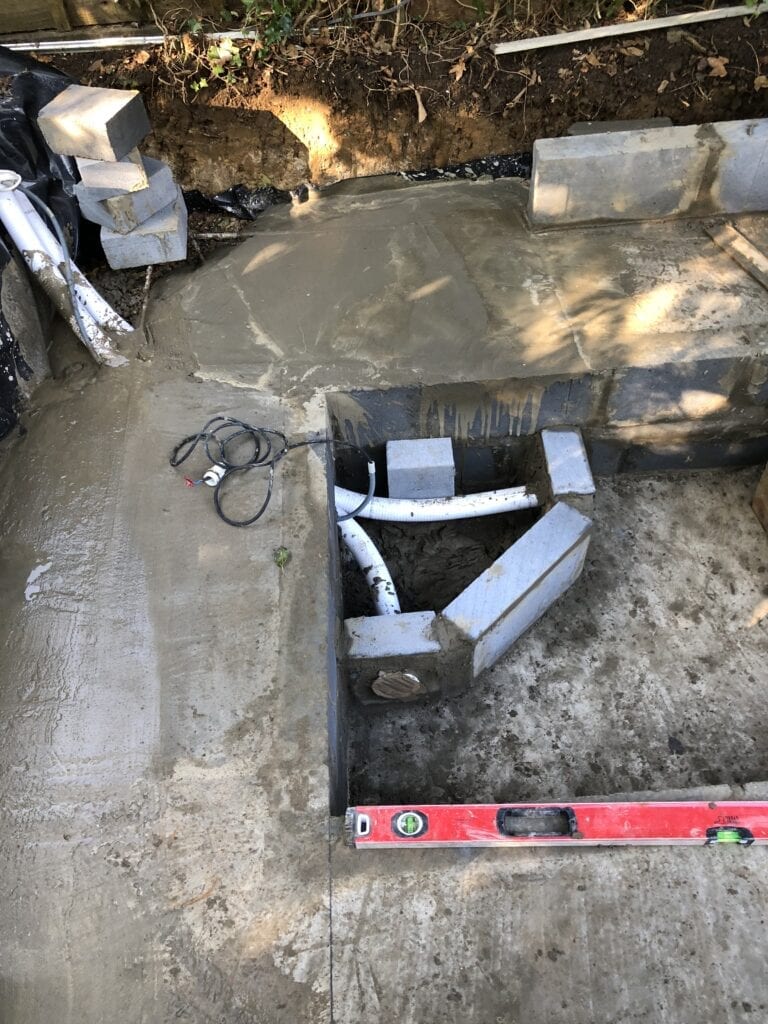
Tiles, Tiling, Adhesive & Grout
Tiles
I am sure that you would have chosen the tiles that you wanted to use before you broke ground. My recommendations are are quite simple, Go for a tile that is suitable for both walls and floors and wet rooms. Also, make sure that it is ceramic tile rather than a porcelain one. Porcelain is not waterproof. Some of the more knowledgeable of you will also argue that neither are ceramic 100%, but they are as good as waterproof really. There are coatings that you can apply to the tiles if you wish to waterproof them. I didn’t bother and just opted for a ceramic grey tile that was held in place and grouted with grey swimming pool adhesive as detailed below. Again, a year on, touch wood, I have not had any problems with them.
Grout Type
This is important. Don’t just go for a water proof grout, you need to go for a swimming pool grade adhesive and grout. You need to have something that is designed to be submerged under water constantly and not just designed to get wet once a day, eg a shower grout. It is not that much more expensive than the regular wet stuff but the performance is much better. I have not had any problems with mine a year on. It has worn away a little so when I service the tub come spring, I’ll be topping up the grout for sure.
Once you have grouted the tiles and stuck them in place, please remember that you need to leave them to cure for 3 weeks. I didn’t realise this at all. As I mentioned, I was on a mission to finish my tub in time for Christmas and this little nugget of information Brough my schedule forward by 3 weeks!
It is not worth cutting is short. You will have spent so much time and effort on the tub, for a tile to come loose in the first couple fo uses because you were impatient would be awful – I sound like my wife now as that is what she said to me when I wanted to fill the tub after two weeks of waiting!
Edging
Edging is something of a personal preference, so I will describe what I used. Baseically, I used the same kind of edging that you find in a bathroom and that can be bought in a DIY shop. I used plastic edging, but there is no reason that if you are going for a higher quality finish, you couldn’t use a metal edging strip. What I would say, is once it is full and the jets are on, nobody really sees what is underneath so if you want to save a bit of cash, this is for sure an area where you could scrimp a little.
Cutting
Cutting the tiles is something that you should definitely not do by hand. The scoring and breaking method in my opinion is hard work. Spend £20 on a cheap wet diamond cutting machine. This will make your life so much easier. If something doesn’t fit, you can trim it. Just be aware of the chips and bits that fly off during the cutting process. This type of machine doesn’t cut per set it is more of a grind.
Finishing Touches
Fur the purpose of this article, I take the finishing touches to be what is going to surround your tub. In my case, I have a deck and a new fence from Western Red Cedar which finishes off the tub in my opinion perfectly. There are lots of different ways that you can finish things off. They depend on your preference, style and of course, most importantly, budget. Grass, artificial grass, Rocks, pants, decking are all options and again are things you need to think about. I should point out that when I cost out the tub, which came in at just under 5 grand, this does not include the finishing touches.
What you do need to consider is wear and tear and durability. For example, I mentioned that you could put grass around your hot tub. That is fine until your kids invade the tub sending gallons of water splashing everywhere. Chlorine and grand do not mix, certainly in the levels that are in the tub so you need to be mindful that things are going to get wet.
Decking, it gets slippy. There are coatings that you can buy that can reduce this, but I just left it as is and people know that it is going to be slippy. Artificial grass, in my opinion looks rubbish unless you spend a lot of money.
Look, finishing touches are important and something to thing about when you are designing your tub. You don’t necessarily have to have them all worked out, but you are going to need a decent idea of what you need and how you want it to look when you are done. Also, think about the area is going to get wet, it will need to endure the weather as it is outside all year, and it does need to be somewhat practical. Worth spending a few extra quid to make it look the part, especially after the amount of time it will have taken you to create.
Audio Visual
Audio Visual is very much a topic that is close to my heart having spent the last 15+ years in the industry. As you would expect, for my own tub there is a good amount of AV included. Let’s start this section with having a look at the AV I put in place and then we can have a look at what else you could add or potentially do with your build.
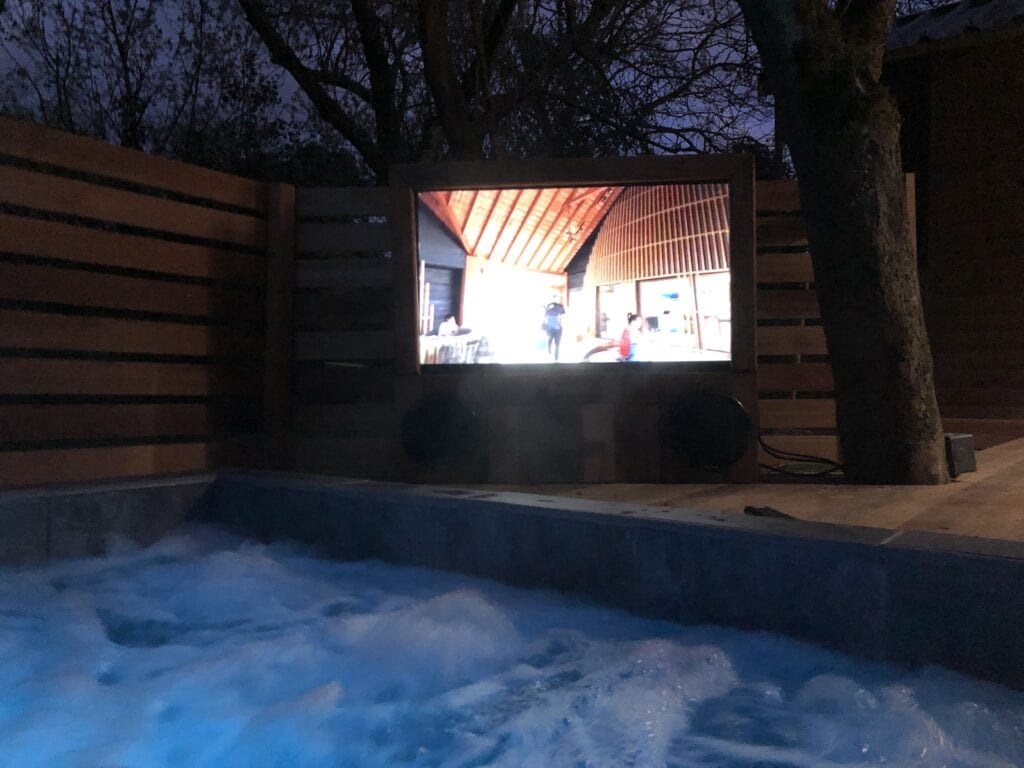
First things first, I guess you are seeing something of a trend here but planning is key. AV should not be an after-thought and should very much be part of your design. AV is also something that you can adjust to fit your budget. I didn’t spend a fortune on my setup and it suits me just fine – but of course it is possible!
For my setup, I wanted to have a TV so I could watch the Football and the F1 in my tub. Most people would agree that putting a cable box or satellite dish in just for this is a bit of an overkill, so I went with the streaming method for which I already have subscriptions in place; so it was not going to cost me any more.
That said, to put a TV in with Internet you need to make some decisions. Having gone down the wireless route previously and been unsuccessful, I was certain that all my connections were going to be hard wired. For me this was not a huge issue because of the proximity to my office and the network switch that I have in there. That said, I still had to run some considerable lengths of cable. If you are going to run ethernet cable, stump up the extra cash and buy outdoor cable. I didn’t done one of the runs and I have had to run a second cable not even a year on. I either broke down in the elements, or what I think is more likely to be the case, it has been chewed by some fury friends. (get used to these if you live in the countryside as I do. Somewhere dry and warm is obviously going to attract some ‘friends’) In hindsight, I should have gone with a couple of runs of cable as it is easier to fault find in the future – this is the setup I have now after having to re-cable. What I mean with this is that if you are going to need a 20m run of cable, instead of running 20m, run 2 x 10m with a connection half way, somewhere convenient to test connectivity if needed. Once you have your cable run, you will of course need some power.
In terms of power, Try and keep things separate from your main feed into your box. I run a loop of power and a few sockets for things like the AV equipment and the lighting.
Sound. You are probably going to want some speakers. Speakers and audio are a wonderful thing and you can really spend the earth on speakers and waterproof ones. I went somewhat simple and opted for a marine grade amplifier and marine grade speakers. They are a decent size, and the audio is just fine for my requirements. Again, placement. I only went for 2 speakers and they are front facing from the TV unit that I constructed, more on that shortly. However, if I were to do things again, I’d probably opt for 4 speakers adding a couple at the rear of the tub as that happens to be where I sit. It would make for a better audio experience I think. With your audio, you don’t want to be messing around with remote control, they will end up 4ft under after a few drinks! Aim to have a manual adjustable volume control that is easily accessible. Mine is on the side of the TV Cabinet and I have the TV hooked into the marine grade speakers and amplifier. Works great to blast out some tunes from YouTube or watch the Football and F1.
How do you choose an outdoor tv I hear you ask! I will let you into a secret, I didn’t! Nearly a year its still working just fine! Outdoor, IP rated TVs cost a fortune, by a fortune I mean at least a couple of grand. When the aim of the project is to keep the cost down, I wanted to look for an alternative. I looked at some of the pre-made enclosures that are IP rated an again, thought that they were a little bit expensive for what I needed. What I have done is choose the cheapest 32” TV I could find, I didn’t care about the audio which is always the problem with cheap TV’s as I knew it was going to go into my amplifier. I then made a housing to cover it. I didn’t need to make it 100% waterproof, it just needed to be splash proof. I decided that the likelihood of me being in the tub, wanting to watch the football in the driving rain was going to be slim to none. So, the enclosure I made has a sheet of waterproof house wrap under the lid, and a Perspex front to protect the screen from splashing in the tub. I then bought a £15 cover off eBay for an outdoor TV which works a treat. I bought a 55” cover an it drops over the cabinet I made. Perfect!
The cabinet was made from some left overs from the decking, the Perspex was about £20 from the DIY store and I did add some internal fans that can be slid out to stop the front glass misting up with condensation from the hot moist air coming out of the tub – genius! 2 PC fans did the trick with a 12V power supply inside the cabinet. Looks the part!
I did drop an Apple TV into the unit connected to the TV so I can stream from my cell phone or use Apple TV in its entirely too if I wish. The “feed” for the TV comes from a HDMI splitter in my bar and I ran a HDMI cable under the decking to the TV.
Things to consider.
Video, what and from where?
Internet, do you need it and from where?
Power – how much and what needs connecting?
Any external pieces of kit?
How are you going to control it?
With this last point, this is one things that is not ideal with my setup. I can’t change the TV channel from my internet TV account without getting out of the tub and heading over to the computer in the bar that drives it. Not the end of the world, but a waterproof wireless keyboard would be an ideal solution – not sure if they exist, not looked!
My cabinet is permanently outside, under the cover which happens to match the colour of my hot tub cover – so it looks quite nice. A confederation would be a mechanism to raise and lower it (that would be very coo
Build a hot tub – Filling and Testing
This for me was probably the most nerve racking and exciting time of the build. Was it going to stay together. Was it going to leak like mad. Was it going to fall apart as soon as a bit of water was in there. Was the filer and pump actually going to work and produce enough bubbles so it at least looked like a Hot Tub. Was it going to heat up to temperature?

I had so many questions going on in my head it was untrue. Nevertheless, it was a super exciting moment to turn on the hose pipe and let it start to fill.
I had calculated that the filling process was going to take best part of 3 hours given that the average hosepipe under normal pressure allows 1000 litres of water an hour to flow. The first part went well and filled up the footwell quite quickly, the water didn’t seem to be escaping so all was good.
I had to wait about another 90 minutes for the water to come up over the seats and again, so far so good. The big test was when the water hit the jets and started to fill the piping, was it going to leak? It didnt.
The next big test was when the water reached the skimmer, it would flow down, through the piping into the pump and the would be ready to be tested. Earlier in the article I explained my woes of power outages so I will not recount the story again here. That said, to test the system, I started the pump on low speed and let it rang for a good 5 minutes.
I was checking all around the Control Room for leaks as that was where most of the joints are and also where some of the more difficult joints were. As I suspected, I had a bit of a drip on the joint that was not 100% square as I did not leave enough room. If that was it, then I was laughing.
I turned the pump onto full and water started spraying everywhere. No problem, just needed a bit of a turn on the screen joints on the top of the pump. Awesome, we had good movement. I turned on the blower and voila! It looked like a hot tub, although at this stage, it was about 8 degrees and a very cold tub. Now it was time to turn on the heater and see if we could heat this body of water up to temperature.
It was quite cold outside as it was December so I knew that this was going to be a slow precess. I left it a couple of hours, went to check and I had moved up a couple degrees. Great I though, this will heat up in no time. Of course, this was not the case.
The heating of water is not a straight line, not is the cooling which we’ll come onto later. For the first 5 or so hours I was heating the water at about a degree an hour, but that soon dropped and I now know that the working time of the heater in cool weather (it was a bit quicker in the summer, more like 1 degree an hour) is 0.5 degrees Celsius an hour. That is fine, it means that you can’t decide an hour before you want to use the tub and it does need a bit of planning, but it is certainly manageable.
Some 40 hours later after I had started the process, I did hit the desired 39 degrees Celsius – I’d done it. I’d built a hot tub, that didn’t leak much (we’ll look at this int he next section) that heated up and looked the part.
You’ll understand the sense of satisfaction this creates when you have designed and built you own.
Repairing any Leaks
Af first, I thought that having to top up the tub up once a week was normal and it was just evaporating. This is not right, you should not have to top it up that often at all. If your water level is dropping, you have a leak.
I had a leak, well, actually I had a couple. The first leak that I had was a constant small leak that came from the bottom of a T join that linked the inlets to the skimmer before they went into the pump feed.
I tried drying it and then using some of the pipe cement, but that was not enough. What I need up having to use was plumbers wet putty which is designed to stop leaks on wet and dry pipes. A chemical reaction allows the putty to set even when things are wet. I went through a couple of tubes of this stuff to get it right but it worked.
The second leak that I had was for the Ozone. I mentioned that I removed the Ozonator from the system as it wasn’t working, but there were too many weak joints. Anything that is held together with a jubilee clip in a high pressure system like a hot tub is going to leak, and this is what happening. Under high pressure, eg when the jets were on full, the joint were leaking water at a rate of knots.
I decided to lock off the system, drain the excess water from the Ozonator section of the pipework and cut it out. I replaced it was regular water pipe and two 90 degree elbows. Job done, no leaks.
A year on, I probably top up the tub every couple of months and this is because of evaporation and when people are going in and out all the time, the water level does drop, but nothing drastic. It also only takes 10mins to bring it back up to the correct level (middle of the skimmer) with the hose pipe.
The thing to remember with the plumbing, is if the joint is made properly, it will not leak. I’m adding to this section now quite a few years since I built the actual hot tub. I have had to repair leaks. The thing is that you can try using epoxy resin or plumbers putty, but really, the best option is that you should cut out the pipe and make the joint again.
Remember, when you are using your pipe cement, use generous amounts but also make sure the pipe that you are using is clean and dry. To make a better connection, you should also use a piece of glass paper to rough up the end so it is not totally smooth – there is less chance that it will actually pull out of the connection.
I found with my tub that in the cold months, when the pipes get really cold and contract is when leaks can form. I have had to repair a few and wherever possible, I have removed the pipe and either cleaned it up and refitted it, or replaced it.
Smaller drips, yes, a bit of epoxy or plumbers putty might help stop, but anything that is causing the water level in your tub to drop definitely needs to be replaced. It is not the easiest to get to pipes once you have finished your tub so this can be a pain I know.
Best cure is prevention so when you make the initial joint, make it properly. Make sure all the connections go 1″/2.5cm into the connects and be generous with the pipe cement
Chemicals & Maintenance
Why do we need Chemicals in a Hot Tub?
We need chemicals in a hot tub primarily to kill bacteria that could breed in a warm damp environment. By using a combination of chemicals we are able to remove the bacteria which could be harmful to us from our Hot Tubs and control the water for longer.
What Chemicals do I need for my Hot Tub?
When we are talking about Hot Tub chemicals, we are really talking about 6 things
- Sanitiser
- pH Increaser
- pH Decreaser
- Total Alkalinity Increaser
- Anti Foam
- Clarifier (optional)
Let’s have a look at what each of them does.
Sanitiser
Sanitiser is the main chemical that is going to kill bacteria in your Hot Tub. There are two main choices here. You can either opt for Bromine or you can choose Chlorine. I am going to write an article at some point about the difference and pros and cons between the two, but for this article, I am going to concentrate on Chlorine as that is what I use in my own tub and it is more popular.
Just as a side note, Bromine is particularly good if you have sensitive skin or react to Chlorine. It means you can still enjoy the Hot Tub without the associated skin complaints!
Bromine is a sanitizer, oxidizer, and algicide that is used in swimming pools and Hot Tubs. In its original state, bromine is a reddish brown liquid, but for pools, it can be found in tablet, granular, stick, and liquid sanitation products (though you would never use pure elemental bromine in a pool or spa). Any liquid bromine products that you may find are diluted with water and other chemicals for safe handling and better performance.
“Bromine” isn’t true bromine, but the name is used to describe any chemical that releases hypobromous acid into the water. This takes place in two ways:
- The two-part system consists of sodium bromine activated by an oxidizer and is typically used in smaller volumes of water (spas).
- The solid, dissolvable form of bromine (tablets, granules, etc.) is formed when bromine is bound to an organic molecule.
What are the Pros and Cons of Chlorine?
A chlorine purification system is the standard method of sanitizing your pool water. Chlorine is added directly to the water to kill bacteria, viruses, and algae. Using chlorine purification system requires the pool owner to test the PH of the water, measure out the correct balance of chemicals, and add them to the water. This system is done routinely by the pool owner as part of their routine pool maintenance.
Chlorine Pros
- Chlorine is a powerful oxidizing agent thereby getting rid of a lot of bacteria in water.
- Chlorine is commercially available
- Chlorine is very economical
Chlorine Cons
- Chlorine does not exterminate all bacteria. Complex microorganisms are known to become dormant in the presence of chlorine but not exactly killed
- Chlorine is not green. It is harmful to the environment.
- Commercially available chlorine (Hypo) disintegrates into Chlorine gas rapidly when exposed
- Super-chlorination poses danger to humans over a period of time
- Downstream water treatment systems like Resins, RO/UF membranes may be damaged by excessive chlorine
What about non-chemical options like UV?
While traditional methods of sanitizing hot tubs, such as chlorine and bromine, have been widely used for many years, there are also non-chemical options available, including UV-C sanitation.
UV-C sanitation, also known as ultraviolet sanitation, is a non-chemical way to keep your hot tub clean and healthy. It works by using ultraviolet light to disrupt the DNA of bacteria, viruses, and other microorganisms, rendering them unable to reproduce and effectively killing them.
UV-C sanitation is a great alternative to traditional chemical sanitation because it does not introduce any additional chemicals into the water. This can be particularly beneficial for individuals who are sensitive or allergic to traditional sanitizing chemicals.
There are several benefits to using UV-C sanitation in your hot tub. First and foremost, it is an effective way to kill bacteria, viruses, and other microorganisms. It can also help reduce the amount of chemicals needed to keep your hot tub clean, which can be more environmentally friendly and cost-effective in the long run.
Another benefit of UV-C sanitation is that it can help reduce the amount of time and effort required to maintain your hot tub. Unlike traditional chemical sanitizers, UV-C sanitation does not require daily or weekly additions to the water, making it a low-maintenance option for hot tub owners.
When using UV-C sanitation in your hot tub, it’s important to follow the manufacturer’s instructions for installation and use. UV-C sanitation systems are typically installed in the plumbing of the hot tub, and the water is circulated through the system to be exposed to the UV-C light.
It’s also important to note that while UV-C sanitation is effective at killing bacteria and viruses, it may not be effective against all types of microorganisms. It is still important to maintain proper water chemistry in your hot tub, including regular testing and balancing of pH and alkalinity levels.
In conclusion, UV-C sanitation is a non-chemical option for hot tub sanitation that can be effective, low-maintenance, and environmentally friendly. If you’re interested in using UV-C sanitation in your hot tub, be sure to research different systems and consult with a professional to ensure proper installation and use.
Time for a Remodel of my DIY Hot Tub
As you can probably tell from reading this article, I did not know a great deal about building a DIY hot tub and I made plenty of mistakes. This website and YouTube Channel serve as testament to this as I explain in great details exactly what I did wrong.
After 4.5 years, it is now time to rectify some of the mistakes that I made when building my DIY Hot Tub and put them right. I also plan to improve the tub too.
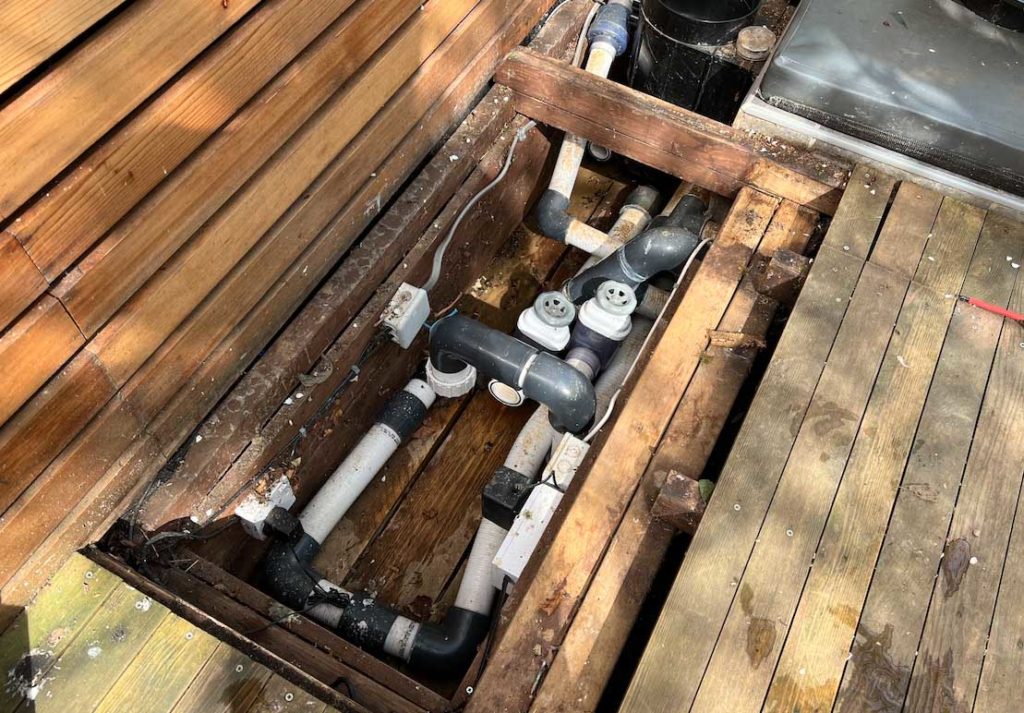
DIY Hot Tub Remodel #1
The first thing that I plan to remodel as we are in April of 2022 is going to be the control room. This is the part of the tub that I am least proud of. I am going to switch out all the plumbing and make it better. I sprung a leak recently so it seemed a more than appropriate time to put the remodel into action on my DIY Hot Tub.
I am also only going to use rigid pipe. The flexible pipe is definitely something I want to avoid. Rigid pipe is not forgiving. I have to be accurate and I have to make a good connection. If I do this – there will be no leaks, simple.
DIY Hot Tub Remodel #2
During the remodel process, I actually fitting an Air Source Heat Pump to a friend’s hot tub. This got me thinking. I need some of that heat up speed increase and cost saving of running the tub. So, I am actually going to alter the plumbing on my DIY Hot Tub to make it compatible with an air source heat pump. This is going to involve splitting the inward plumbing and being a little creative on the hot water returns to the tub as I don’t want to drill or core any holes into my tub as it is still nice and water tight inside.

